Introduction: Human Resource Management Assignment
VerifiedAdded on 2021/10/06
|18
|7168
|164
AI Summary
Contribute Materials
Your contribution can guide someone’s learning journey. Share your
documents today.
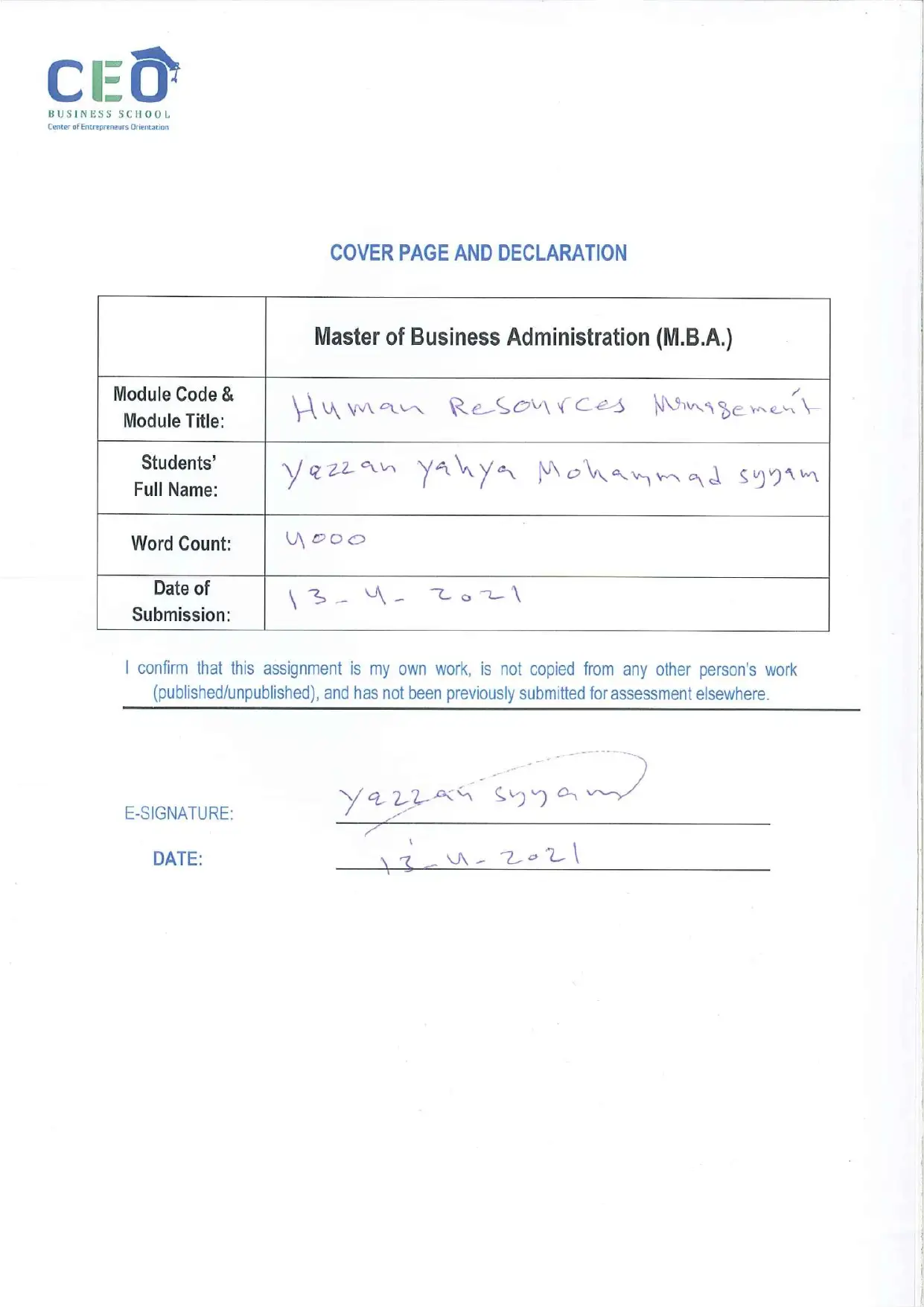
Secure Best Marks with AI Grader
Need help grading? Try our AI Grader for instant feedback on your assignments.
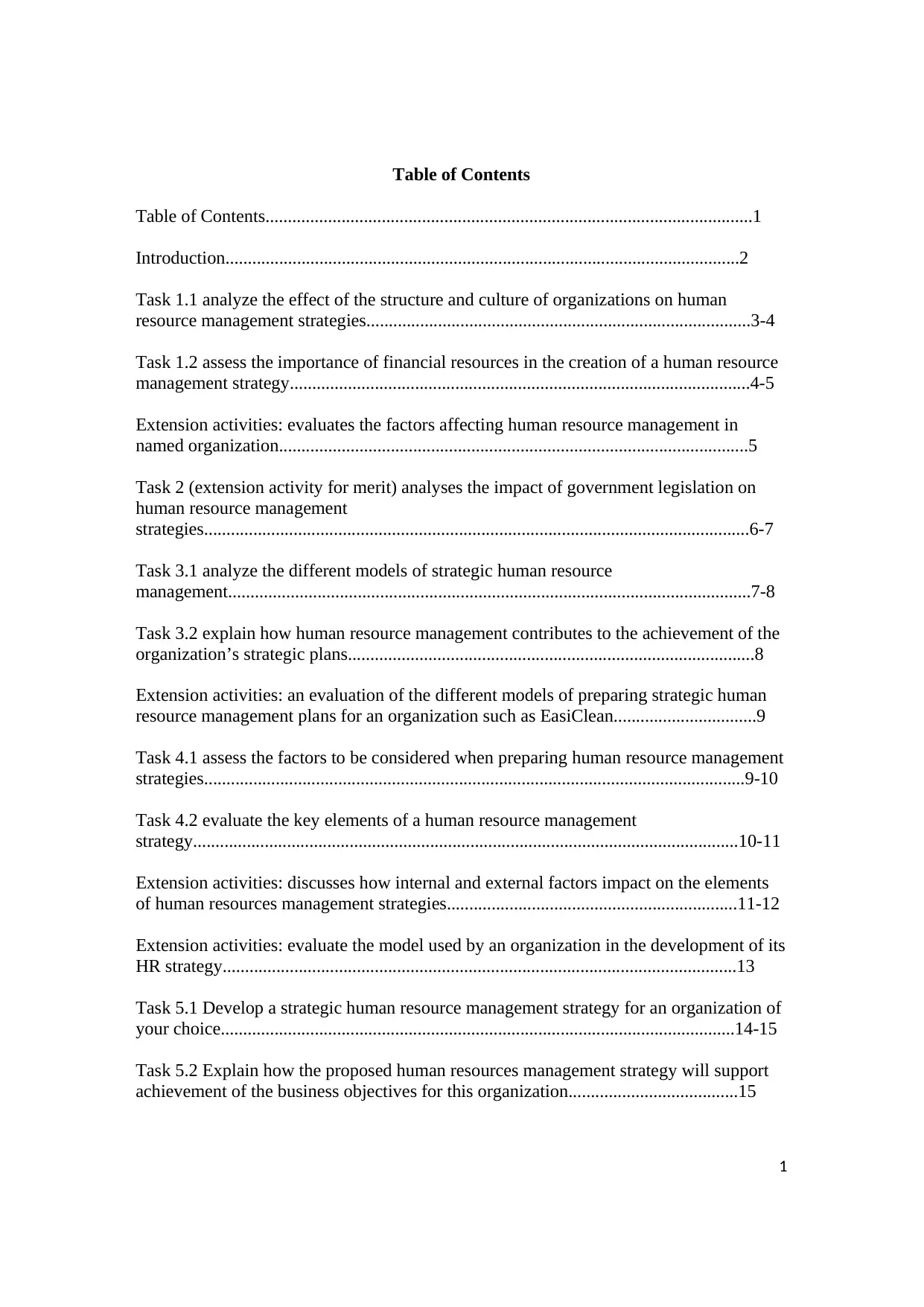
1
Table of Contents
Table of Contents.............................................................................................................1
Introduction...................................................................................................................2
Task 1.1 analyze the effect of the structure and culture of organizations on human
resource management strategies......................................................................................3-4
Task 1.2 assess the importance of financial resources in the creation of a human resource
management strategy.......................................................................................................4-5
Extension activities: evaluates the factors affecting human resource management in
named organization.........................................................................................................5
Task 2 (extension activity for merit) analyses the impact of government legislation on
human resource management
strategies..........................................................................................................................6-7
Task 3.1 analyze the different models of strategic human resource
management.....................................................................................................................7-8
Task 3.2 explain how human resource management contributes to the achievement of the
organization’s strategic plans...........................................................................................8
Extension activities: an evaluation of the different models of preparing strategic human
resource management plans for an organization such as EasiClean................................9
Task 4.1 assess the factors to be considered when preparing human resource management
strategies.........................................................................................................................9-10
Task 4.2 evaluate the key elements of a human resource management
strategy..........................................................................................................................10-11
Extension activities: discusses how internal and external factors impact on the elements
of human resources management strategies.................................................................11-12
Extension activities: evaluate the model used by an organization in the development of its
HR strategy...................................................................................................................13
Task 5.1 Develop a strategic human resource management strategy for an organization of
your choice...................................................................................................................14-15
Task 5.2 Explain how the proposed human resources management strategy will support
achievement of the business objectives for this organization......................................15
Table of Contents
Table of Contents.............................................................................................................1
Introduction...................................................................................................................2
Task 1.1 analyze the effect of the structure and culture of organizations on human
resource management strategies......................................................................................3-4
Task 1.2 assess the importance of financial resources in the creation of a human resource
management strategy.......................................................................................................4-5
Extension activities: evaluates the factors affecting human resource management in
named organization.........................................................................................................5
Task 2 (extension activity for merit) analyses the impact of government legislation on
human resource management
strategies..........................................................................................................................6-7
Task 3.1 analyze the different models of strategic human resource
management.....................................................................................................................7-8
Task 3.2 explain how human resource management contributes to the achievement of the
organization’s strategic plans...........................................................................................8
Extension activities: an evaluation of the different models of preparing strategic human
resource management plans for an organization such as EasiClean................................9
Task 4.1 assess the factors to be considered when preparing human resource management
strategies.........................................................................................................................9-10
Task 4.2 evaluate the key elements of a human resource management
strategy..........................................................................................................................10-11
Extension activities: discusses how internal and external factors impact on the elements
of human resources management strategies.................................................................11-12
Extension activities: evaluate the model used by an organization in the development of its
HR strategy...................................................................................................................13
Task 5.1 Develop a strategic human resource management strategy for an organization of
your choice...................................................................................................................14-15
Task 5.2 Explain how the proposed human resources management strategy will support
achievement of the business objectives for this organization......................................15
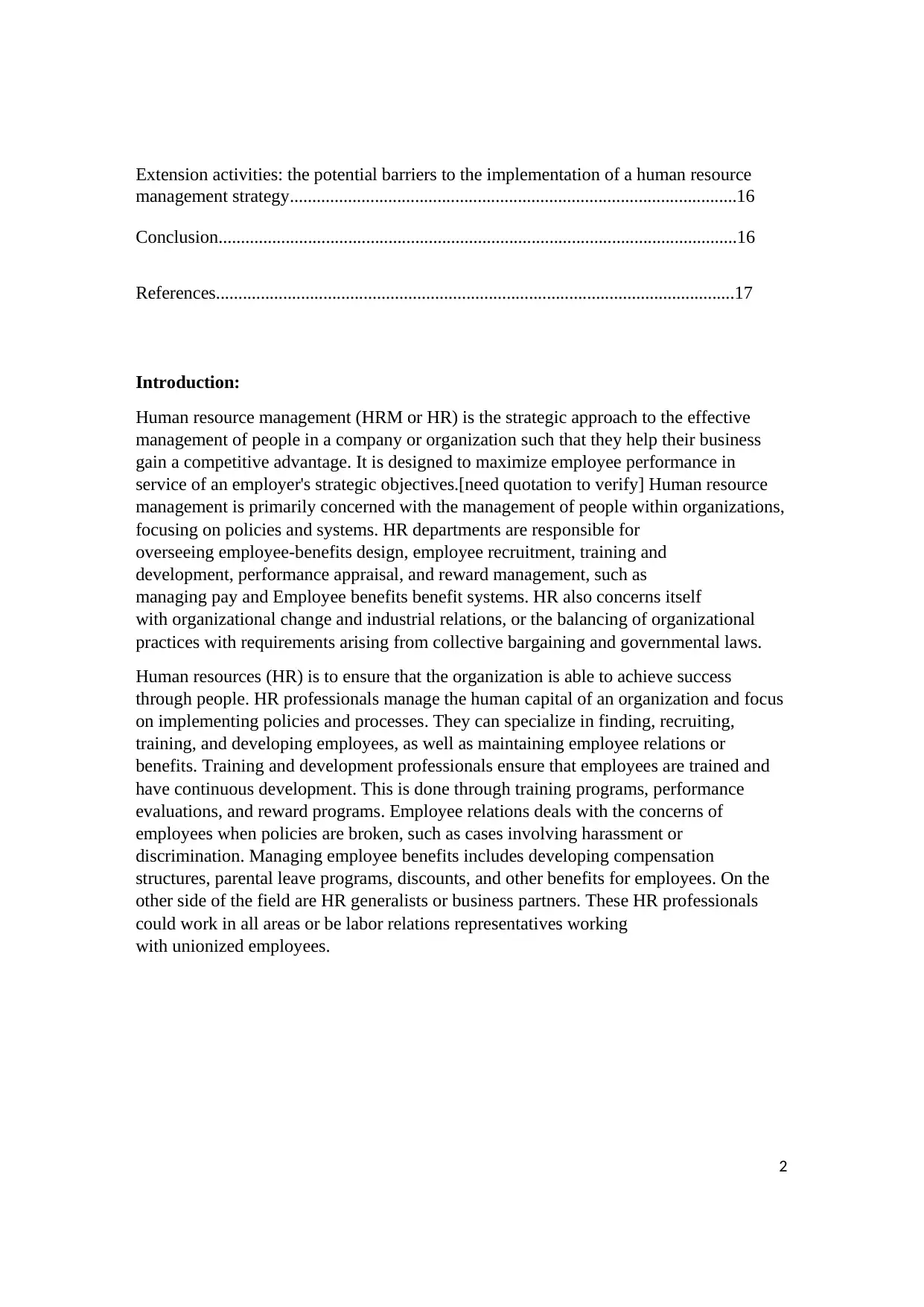
2
Extension activities: the potential barriers to the implementation of a human resource
management strategy....................................................................................................16
Conclusion....................................................................................................................16
References....................................................................................................................17
Introduction:
Human resource management (HRM or HR) is the strategic approach to the effective
management of people in a company or organization such that they help their business
gain a competitive advantage. It is designed to maximize employee performance in
service of an employer's strategic objectives.[need quotation to verify] Human resource
management is primarily concerned with the management of people within organizations,
focusing on policies and systems. HR departments are responsible for
overseeing employee-benefits design, employee recruitment, training and
development, performance appraisal, and reward management, such as
managing pay and Employee benefits benefit systems. HR also concerns itself
with organizational change and industrial relations, or the balancing of organizational
practices with requirements arising from collective bargaining and governmental laws.
Human resources (HR) is to ensure that the organization is able to achieve success
through people. HR professionals manage the human capital of an organization and focus
on implementing policies and processes. They can specialize in finding, recruiting,
training, and developing employees, as well as maintaining employee relations or
benefits. Training and development professionals ensure that employees are trained and
have continuous development. This is done through training programs, performance
evaluations, and reward programs. Employee relations deals with the concerns of
employees when policies are broken, such as cases involving harassment or
discrimination. Managing employee benefits includes developing compensation
structures, parental leave programs, discounts, and other benefits for employees. On the
other side of the field are HR generalists or business partners. These HR professionals
could work in all areas or be labor relations representatives working
with unionized employees.
Extension activities: the potential barriers to the implementation of a human resource
management strategy....................................................................................................16
Conclusion....................................................................................................................16
References....................................................................................................................17
Introduction:
Human resource management (HRM or HR) is the strategic approach to the effective
management of people in a company or organization such that they help their business
gain a competitive advantage. It is designed to maximize employee performance in
service of an employer's strategic objectives.[need quotation to verify] Human resource
management is primarily concerned with the management of people within organizations,
focusing on policies and systems. HR departments are responsible for
overseeing employee-benefits design, employee recruitment, training and
development, performance appraisal, and reward management, such as
managing pay and Employee benefits benefit systems. HR also concerns itself
with organizational change and industrial relations, or the balancing of organizational
practices with requirements arising from collective bargaining and governmental laws.
Human resources (HR) is to ensure that the organization is able to achieve success
through people. HR professionals manage the human capital of an organization and focus
on implementing policies and processes. They can specialize in finding, recruiting,
training, and developing employees, as well as maintaining employee relations or
benefits. Training and development professionals ensure that employees are trained and
have continuous development. This is done through training programs, performance
evaluations, and reward programs. Employee relations deals with the concerns of
employees when policies are broken, such as cases involving harassment or
discrimination. Managing employee benefits includes developing compensation
structures, parental leave programs, discounts, and other benefits for employees. On the
other side of the field are HR generalists or business partners. These HR professionals
could work in all areas or be labor relations representatives working
with unionized employees.
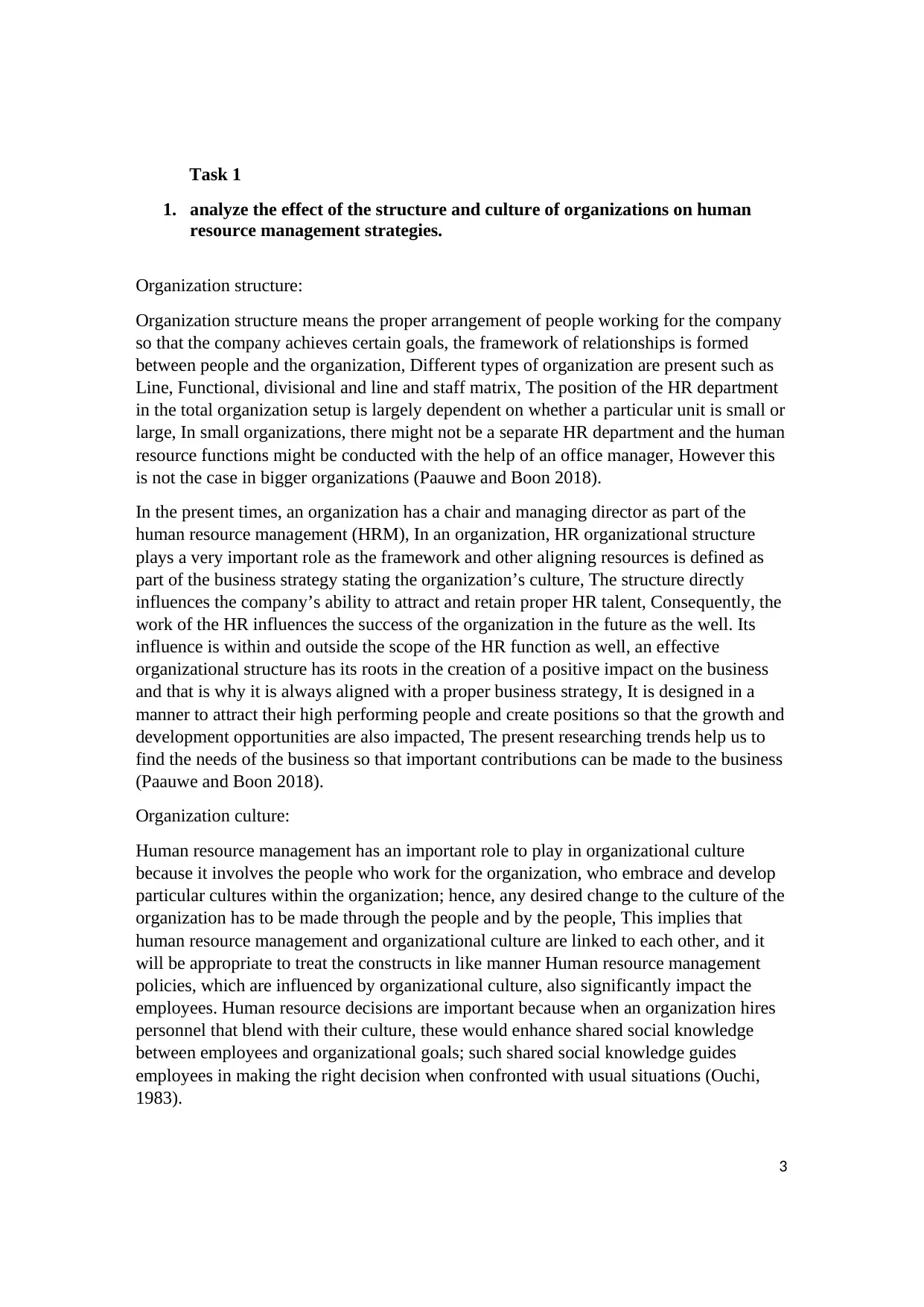
3
Task 1
1. analyze the effect of the structure and culture of organizations on human
resource management strategies.
Organization structure:
Organization structure means the proper arrangement of people working for the company
so that the company achieves certain goals, the framework of relationships is formed
between people and the organization, Different types of organization are present such as
Line, Functional, divisional and line and staff matrix, The position of the HR department
in the total organization setup is largely dependent on whether a particular unit is small or
large, In small organizations, there might not be a separate HR department and the human
resource functions might be conducted with the help of an office manager, However this
is not the case in bigger organizations (Paauwe and Boon 2018).
In the present times, an organization has a chair and managing director as part of the
human resource management (HRM), In an organization, HR organizational structure
plays a very important role as the framework and other aligning resources is defined as
part of the business strategy stating the organization’s culture, The structure directly
influences the company’s ability to attract and retain proper HR talent, Consequently, the
work of the HR influences the success of the organization in the future as the well. Its
influence is within and outside the scope of the HR function as well, an effective
organizational structure has its roots in the creation of a positive impact on the business
and that is why it is always aligned with a proper business strategy, It is designed in a
manner to attract their high performing people and create positions so that the growth and
development opportunities are also impacted, The present researching trends help us to
find the needs of the business so that important contributions can be made to the business
(Paauwe and Boon 2018).
Organization culture:
Human resource management has an important role to play in organizational culture
because it involves the people who work for the organization, who embrace and develop
particular cultures within the organization; hence, any desired change to the culture of the
organization has to be made through the people and by the people, This implies that
human resource management and organizational culture are linked to each other, and it
will be appropriate to treat the constructs in like manner Human resource management
policies, which are influenced by organizational culture, also significantly impact the
employees. Human resource decisions are important because when an organization hires
personnel that blend with their culture, these would enhance shared social knowledge
between employees and organizational goals; such shared social knowledge guides
employees in making the right decision when confronted with usual situations (Ouchi,
1983).
Task 1
1. analyze the effect of the structure and culture of organizations on human
resource management strategies.
Organization structure:
Organization structure means the proper arrangement of people working for the company
so that the company achieves certain goals, the framework of relationships is formed
between people and the organization, Different types of organization are present such as
Line, Functional, divisional and line and staff matrix, The position of the HR department
in the total organization setup is largely dependent on whether a particular unit is small or
large, In small organizations, there might not be a separate HR department and the human
resource functions might be conducted with the help of an office manager, However this
is not the case in bigger organizations (Paauwe and Boon 2018).
In the present times, an organization has a chair and managing director as part of the
human resource management (HRM), In an organization, HR organizational structure
plays a very important role as the framework and other aligning resources is defined as
part of the business strategy stating the organization’s culture, The structure directly
influences the company’s ability to attract and retain proper HR talent, Consequently, the
work of the HR influences the success of the organization in the future as the well. Its
influence is within and outside the scope of the HR function as well, an effective
organizational structure has its roots in the creation of a positive impact on the business
and that is why it is always aligned with a proper business strategy, It is designed in a
manner to attract their high performing people and create positions so that the growth and
development opportunities are also impacted, The present researching trends help us to
find the needs of the business so that important contributions can be made to the business
(Paauwe and Boon 2018).
Organization culture:
Human resource management has an important role to play in organizational culture
because it involves the people who work for the organization, who embrace and develop
particular cultures within the organization; hence, any desired change to the culture of the
organization has to be made through the people and by the people, This implies that
human resource management and organizational culture are linked to each other, and it
will be appropriate to treat the constructs in like manner Human resource management
policies, which are influenced by organizational culture, also significantly impact the
employees. Human resource decisions are important because when an organization hires
personnel that blend with their culture, these would enhance shared social knowledge
between employees and organizational goals; such shared social knowledge guides
employees in making the right decision when confronted with usual situations (Ouchi,
1983).
Secure Best Marks with AI Grader
Need help grading? Try our AI Grader for instant feedback on your assignments.

4
A symbiotic relationship exists between HRM policies and organizational culture,
wherein four human resource policy areas; staffing, training, compensation, and
evaluation of employees, have significant effects on organizational culture, this symbiotic
relationship is defined by three variables, namely management time constraints,
management experience and market characteristics, If HRM practices are not in
conformity with the organizational values shared by employees, then employees will feel
unsatisfied, uncomfortable and uncommitted, thereby resulting in low performance
because their values are different from the company’s expectations (Cooper, 1998).
The relationship between organizational culture and human resources practices is such
that when employees understand and internalize the organizational culture, this enables
employees to choose the strategy and behavior that fit their personality as well as with the
main routines of the organization’s activities, As human resource management is
responsible for recognizing the competitive advantages in corporate culture, an
organization can differentiate itself from its competitors by attracting many excellent
candidates and by selling itself as the best employer (Saffold, 1988).
2. assess the importance of financial resources in the creation of a human
resource management strategy.
Employees drive business results and create value for the organization. HR as a function
has the responsibility of supporting employee well-being, which in turn helps create a
competitive advantage by building a happy and healthy workforce., It is important to
highlight that business results are generally measured in financial terms and not in terms
of employee health. Finance and business operations are speaking the same language
while HR adds another tangent, putting HR at a slight disadvantage (Huselid, M. A., &
Becker, B. E. (2011))
In many organizations, human resources and finance are two distinct business areas.
Finance helps allocate resources to support an organization's goals, maintaining a balance
between costs and revenue. HR hires, recruits and motivates people to advance those
same goals. This part of HR is often an organization's biggest expense. While they are
two different operations, it's important to have collaboration between HR and finance
within an organization. Without that, it will be difficult for those respective entities to
fully support organizational objectives (Huselid, M. A., & Becker, B. E. (2011)).
Any strategy requires resources for execution and one of the key responsibilities of HR is
to make sure the organization has resources with the right skills and competencies in the
right positions. HR also needs to help keep talent engaged, in turn improving retention.
To achieve this objective, HR is largely dependent on finance for things like budget, new
hiring activity, or for training the existing workforce for programs that increase employee
engagement. This is where finance struggles as they need to rationalize costs when they
can’t measure the return on investment and justify the value. Conversely, how does
finance make sure they get good top line results from people and get the help from HR to
A symbiotic relationship exists between HRM policies and organizational culture,
wherein four human resource policy areas; staffing, training, compensation, and
evaluation of employees, have significant effects on organizational culture, this symbiotic
relationship is defined by three variables, namely management time constraints,
management experience and market characteristics, If HRM practices are not in
conformity with the organizational values shared by employees, then employees will feel
unsatisfied, uncomfortable and uncommitted, thereby resulting in low performance
because their values are different from the company’s expectations (Cooper, 1998).
The relationship between organizational culture and human resources practices is such
that when employees understand and internalize the organizational culture, this enables
employees to choose the strategy and behavior that fit their personality as well as with the
main routines of the organization’s activities, As human resource management is
responsible for recognizing the competitive advantages in corporate culture, an
organization can differentiate itself from its competitors by attracting many excellent
candidates and by selling itself as the best employer (Saffold, 1988).
2. assess the importance of financial resources in the creation of a human
resource management strategy.
Employees drive business results and create value for the organization. HR as a function
has the responsibility of supporting employee well-being, which in turn helps create a
competitive advantage by building a happy and healthy workforce., It is important to
highlight that business results are generally measured in financial terms and not in terms
of employee health. Finance and business operations are speaking the same language
while HR adds another tangent, putting HR at a slight disadvantage (Huselid, M. A., &
Becker, B. E. (2011))
In many organizations, human resources and finance are two distinct business areas.
Finance helps allocate resources to support an organization's goals, maintaining a balance
between costs and revenue. HR hires, recruits and motivates people to advance those
same goals. This part of HR is often an organization's biggest expense. While they are
two different operations, it's important to have collaboration between HR and finance
within an organization. Without that, it will be difficult for those respective entities to
fully support organizational objectives (Huselid, M. A., & Becker, B. E. (2011)).
Any strategy requires resources for execution and one of the key responsibilities of HR is
to make sure the organization has resources with the right skills and competencies in the
right positions. HR also needs to help keep talent engaged, in turn improving retention.
To achieve this objective, HR is largely dependent on finance for things like budget, new
hiring activity, or for training the existing workforce for programs that increase employee
engagement. This is where finance struggles as they need to rationalize costs when they
can’t measure the return on investment and justify the value. Conversely, how does
finance make sure they get good top line results from people and get the help from HR to
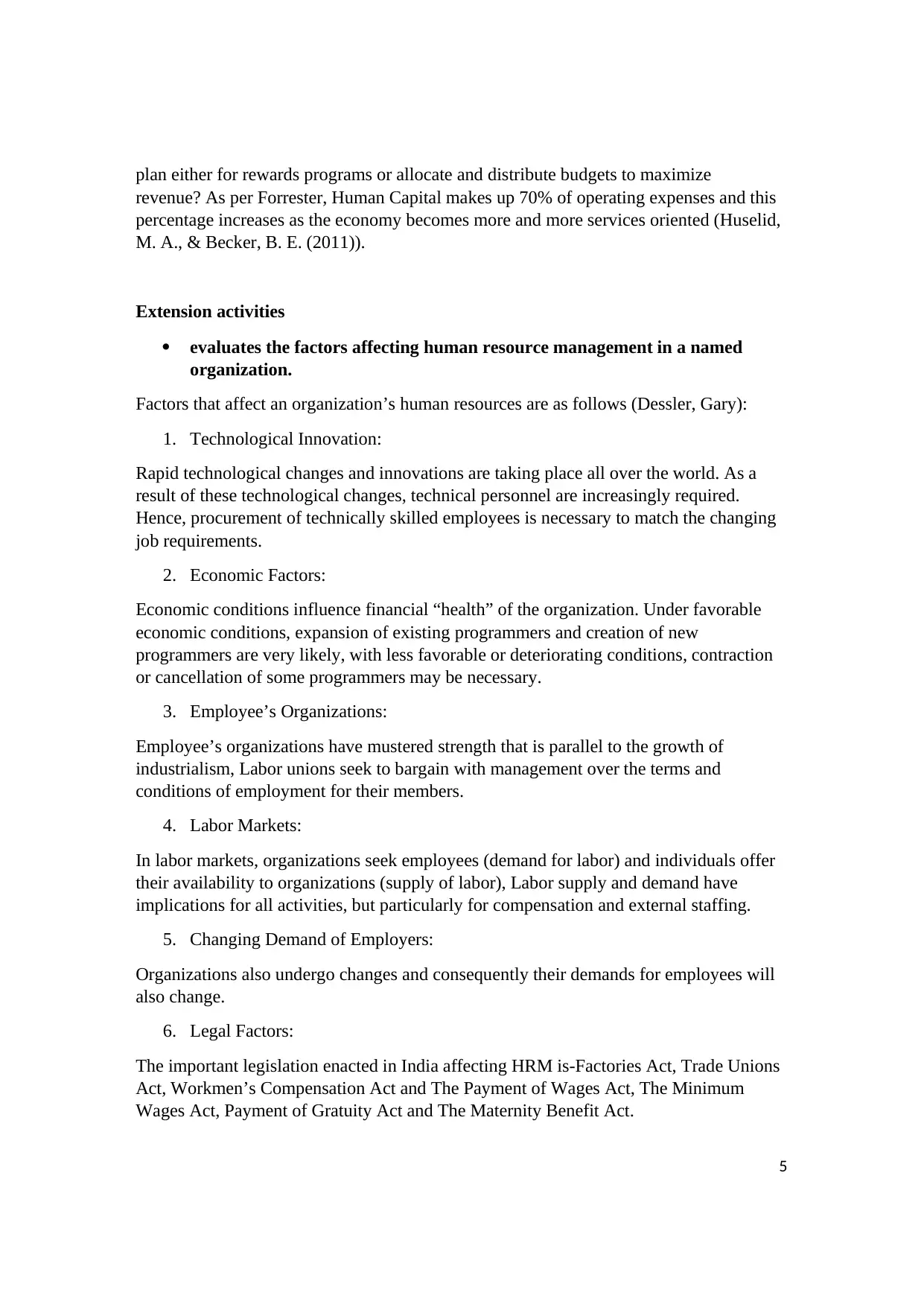
5
plan either for rewards programs or allocate and distribute budgets to maximize
revenue? As per Forrester, Human Capital makes up 70% of operating expenses and this
percentage increases as the economy becomes more and more services oriented (Huselid,
M. A., & Becker, B. E. (2011)).
Extension activities
evaluates the factors affecting human resource management in a named
organization.
Factors that affect an organization’s human resources are as follows (Dessler, Gary):
1. Technological Innovation:
Rapid technological changes and innovations are taking place all over the world. As a
result of these technological changes, technical personnel are increasingly required.
Hence, procurement of technically skilled employees is necessary to match the changing
job requirements.
2. Economic Factors:
Economic conditions influence financial “health” of the organization. Under favorable
economic conditions, expansion of existing programmers and creation of new
programmers are very likely, with less favorable or deteriorating conditions, contraction
or cancellation of some programmers may be necessary.
3. Employee’s Organizations:
Employee’s organizations have mustered strength that is parallel to the growth of
industrialism, Labor unions seek to bargain with management over the terms and
conditions of employment for their members.
4. Labor Markets:
In labor markets, organizations seek employees (demand for labor) and individuals offer
their availability to organizations (supply of labor), Labor supply and demand have
implications for all activities, but particularly for compensation and external staffing.
5. Changing Demand of Employers:
Organizations also undergo changes and consequently their demands for employees will
also change.
6. Legal Factors:
The important legislation enacted in India affecting HRM is-Factories Act, Trade Unions
Act, Workmen’s Compensation Act and The Payment of Wages Act, The Minimum
Wages Act, Payment of Gratuity Act and The Maternity Benefit Act.
plan either for rewards programs or allocate and distribute budgets to maximize
revenue? As per Forrester, Human Capital makes up 70% of operating expenses and this
percentage increases as the economy becomes more and more services oriented (Huselid,
M. A., & Becker, B. E. (2011)).
Extension activities
evaluates the factors affecting human resource management in a named
organization.
Factors that affect an organization’s human resources are as follows (Dessler, Gary):
1. Technological Innovation:
Rapid technological changes and innovations are taking place all over the world. As a
result of these technological changes, technical personnel are increasingly required.
Hence, procurement of technically skilled employees is necessary to match the changing
job requirements.
2. Economic Factors:
Economic conditions influence financial “health” of the organization. Under favorable
economic conditions, expansion of existing programmers and creation of new
programmers are very likely, with less favorable or deteriorating conditions, contraction
or cancellation of some programmers may be necessary.
3. Employee’s Organizations:
Employee’s organizations have mustered strength that is parallel to the growth of
industrialism, Labor unions seek to bargain with management over the terms and
conditions of employment for their members.
4. Labor Markets:
In labor markets, organizations seek employees (demand for labor) and individuals offer
their availability to organizations (supply of labor), Labor supply and demand have
implications for all activities, but particularly for compensation and external staffing.
5. Changing Demand of Employers:
Organizations also undergo changes and consequently their demands for employees will
also change.
6. Legal Factors:
The important legislation enacted in India affecting HRM is-Factories Act, Trade Unions
Act, Workmen’s Compensation Act and The Payment of Wages Act, The Minimum
Wages Act, Payment of Gratuity Act and The Maternity Benefit Act.
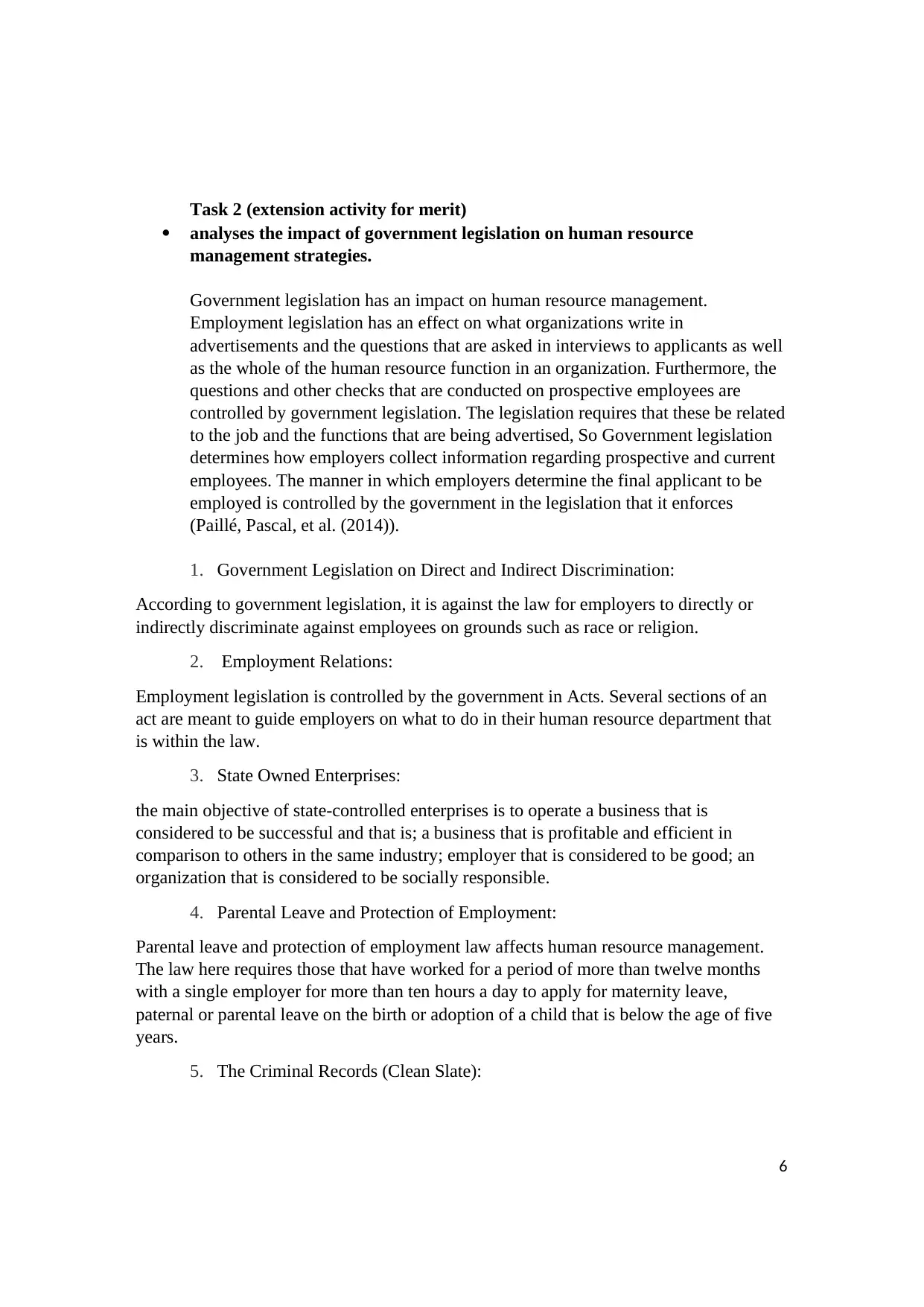
6
Task 2 (extension activity for merit)
analyses the impact of government legislation on human resource
management strategies.
Government legislation has an impact on human resource management.
Employment legislation has an effect on what organizations write in
advertisements and the questions that are asked in interviews to applicants as well
as the whole of the human resource function in an organization. Furthermore, the
questions and other checks that are conducted on prospective employees are
controlled by government legislation. The legislation requires that these be related
to the job and the functions that are being advertised, So Government legislation
determines how employers collect information regarding prospective and current
employees. The manner in which employers determine the final applicant to be
employed is controlled by the government in the legislation that it enforces
(Paillé, Pascal, et al. (2014)).
1. Government Legislation on Direct and Indirect Discrimination:
According to government legislation, it is against the law for employers to directly or
indirectly discriminate against employees on grounds such as race or religion.
2. Employment Relations:
Employment legislation is controlled by the government in Acts. Several sections of an
act are meant to guide employers on what to do in their human resource department that
is within the law.
3. State Owned Enterprises:
the main objective of state-controlled enterprises is to operate a business that is
considered to be successful and that is; a business that is profitable and efficient in
comparison to others in the same industry; employer that is considered to be good; an
organization that is considered to be socially responsible.
4. Parental Leave and Protection of Employment:
Parental leave and protection of employment law affects human resource management.
The law here requires those that have worked for a period of more than twelve months
with a single employer for more than ten hours a day to apply for maternity leave,
paternal or parental leave on the birth or adoption of a child that is below the age of five
years.
5. The Criminal Records (Clean Slate):
Task 2 (extension activity for merit)
analyses the impact of government legislation on human resource
management strategies.
Government legislation has an impact on human resource management.
Employment legislation has an effect on what organizations write in
advertisements and the questions that are asked in interviews to applicants as well
as the whole of the human resource function in an organization. Furthermore, the
questions and other checks that are conducted on prospective employees are
controlled by government legislation. The legislation requires that these be related
to the job and the functions that are being advertised, So Government legislation
determines how employers collect information regarding prospective and current
employees. The manner in which employers determine the final applicant to be
employed is controlled by the government in the legislation that it enforces
(Paillé, Pascal, et al. (2014)).
1. Government Legislation on Direct and Indirect Discrimination:
According to government legislation, it is against the law for employers to directly or
indirectly discriminate against employees on grounds such as race or religion.
2. Employment Relations:
Employment legislation is controlled by the government in Acts. Several sections of an
act are meant to guide employers on what to do in their human resource department that
is within the law.
3. State Owned Enterprises:
the main objective of state-controlled enterprises is to operate a business that is
considered to be successful and that is; a business that is profitable and efficient in
comparison to others in the same industry; employer that is considered to be good; an
organization that is considered to be socially responsible.
4. Parental Leave and Protection of Employment:
Parental leave and protection of employment law affects human resource management.
The law here requires those that have worked for a period of more than twelve months
with a single employer for more than ten hours a day to apply for maternity leave,
paternal or parental leave on the birth or adoption of a child that is below the age of five
years.
5. The Criminal Records (Clean Slate):
Paraphrase This Document
Need a fresh take? Get an instant paraphrase of this document with our AI Paraphraser
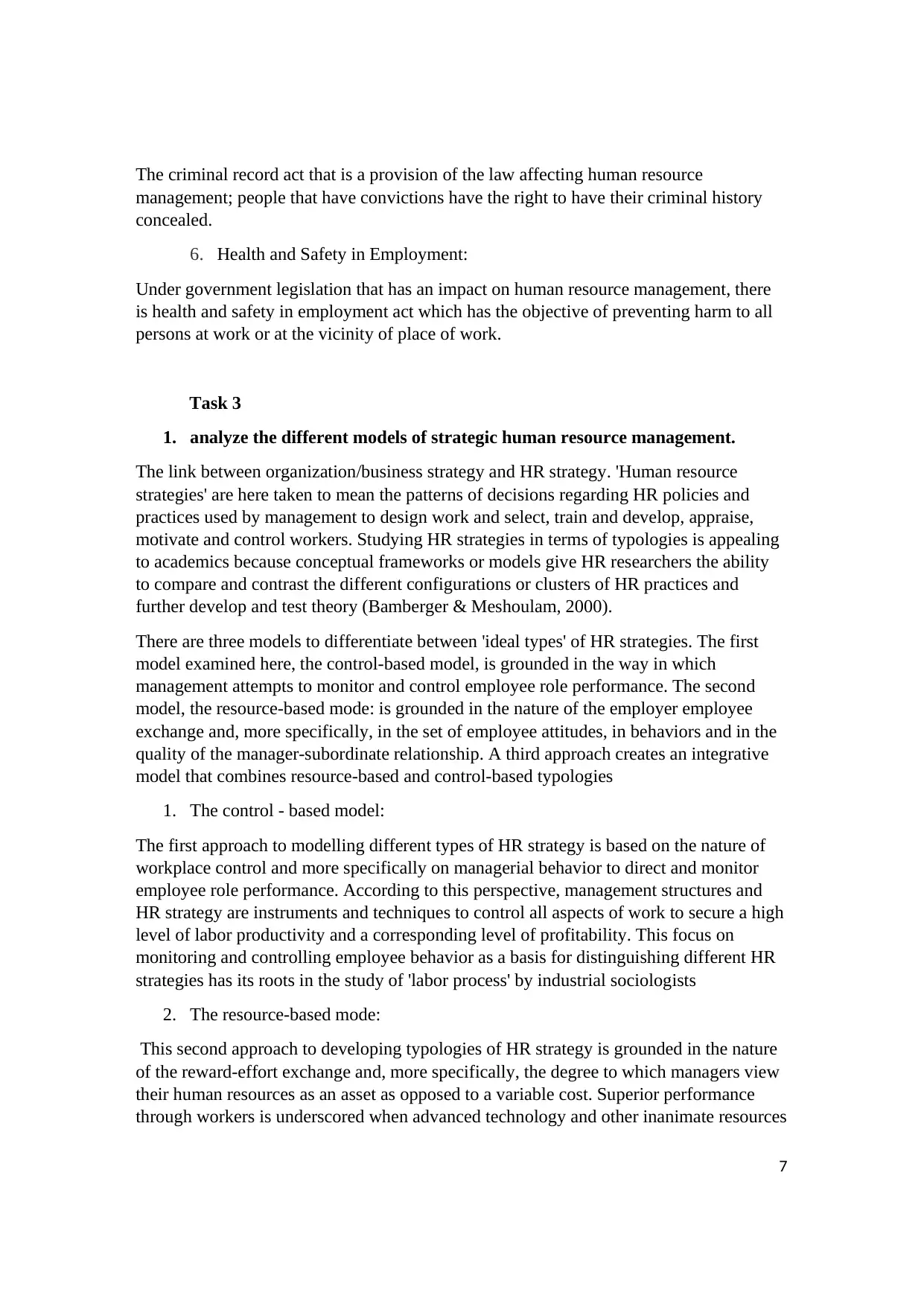
7
The criminal record act that is a provision of the law affecting human resource
management; people that have convictions have the right to have their criminal history
concealed.
6. Health and Safety in Employment:
Under government legislation that has an impact on human resource management, there
is health and safety in employment act which has the objective of preventing harm to all
persons at work or at the vicinity of place of work.
Task 3
1. analyze the different models of strategic human resource management.
The link between organization/business strategy and HR strategy. 'Human resource
strategies' are here taken to mean the patterns of decisions regarding HR policies and
practices used by management to design work and select, train and develop, appraise,
motivate and control workers. Studying HR strategies in terms of typologies is appealing
to academics because conceptual frameworks or models give HR researchers the ability
to compare and contrast the different configurations or clusters of HR practices and
further develop and test theory (Bamberger & Meshoulam, 2000).
There are three models to differentiate between 'ideal types' of HR strategies. The first
model examined here, the control-based model, is grounded in the way in which
management attempts to monitor and control employee role performance. The second
model, the resource-based mode: is grounded in the nature of the employer employee
exchange and, more specifically, in the set of employee attitudes, in behaviors and in the
quality of the manager-subordinate relationship. A third approach creates an integrative
model that combines resource-based and control-based typologies
1. The control - based model:
The first approach to modelling different types of HR strategy is based on the nature of
workplace control and more specifically on managerial behavior to direct and monitor
employee role performance. According to this perspective, management structures and
HR strategy are instruments and techniques to control all aspects of work to secure a high
level of labor productivity and a corresponding level of profitability. This focus on
monitoring and controlling employee behavior as a basis for distinguishing different HR
strategies has its roots in the study of 'labor process' by industrial sociologists
2. The resource-based mode:
This second approach to developing typologies of HR strategy is grounded in the nature
of the reward-effort exchange and, more specifically, the degree to which managers view
their human resources as an asset as opposed to a variable cost. Superior performance
through workers is underscored when advanced technology and other inanimate resources
The criminal record act that is a provision of the law affecting human resource
management; people that have convictions have the right to have their criminal history
concealed.
6. Health and Safety in Employment:
Under government legislation that has an impact on human resource management, there
is health and safety in employment act which has the objective of preventing harm to all
persons at work or at the vicinity of place of work.
Task 3
1. analyze the different models of strategic human resource management.
The link between organization/business strategy and HR strategy. 'Human resource
strategies' are here taken to mean the patterns of decisions regarding HR policies and
practices used by management to design work and select, train and develop, appraise,
motivate and control workers. Studying HR strategies in terms of typologies is appealing
to academics because conceptual frameworks or models give HR researchers the ability
to compare and contrast the different configurations or clusters of HR practices and
further develop and test theory (Bamberger & Meshoulam, 2000).
There are three models to differentiate between 'ideal types' of HR strategies. The first
model examined here, the control-based model, is grounded in the way in which
management attempts to monitor and control employee role performance. The second
model, the resource-based mode: is grounded in the nature of the employer employee
exchange and, more specifically, in the set of employee attitudes, in behaviors and in the
quality of the manager-subordinate relationship. A third approach creates an integrative
model that combines resource-based and control-based typologies
1. The control - based model:
The first approach to modelling different types of HR strategy is based on the nature of
workplace control and more specifically on managerial behavior to direct and monitor
employee role performance. According to this perspective, management structures and
HR strategy are instruments and techniques to control all aspects of work to secure a high
level of labor productivity and a corresponding level of profitability. This focus on
monitoring and controlling employee behavior as a basis for distinguishing different HR
strategies has its roots in the study of 'labor process' by industrial sociologists
2. The resource-based mode:
This second approach to developing typologies of HR strategy is grounded in the nature
of the reward-effort exchange and, more specifically, the degree to which managers view
their human resources as an asset as opposed to a variable cost. Superior performance
through workers is underscored when advanced technology and other inanimate resources

8
are readily available to competing firms. The sum of people's knowledge and expertise,
and social relationships, has the potential to provide non-substitutable capabilities that
serve as a source of competitive advantage
3. The integrative model:
Integrate the two main models of HR strategy, one focusing on the strategy's underlying
logic of managerial control, the other focusing on the reward-effort exchange. Arguing
that neither of the two dichotomous approaches (control- and resource-based models)
provides a framework able to encompass the ebb and flow of the intensity and direction
of HR strategy, they build a model that characterizes the two main dimensions of HR
strategy as involving 'acquisition and development' and the 'locus of control'.
2. explain how human resource management contributes to the achievement of
the organization’s strategic plans.
Integrating human resource management into your strategic planning process enables you
to ensure that as you identify goals, opportunities and competitive advantages, you can
recruit, hire and develop the right workforce to achieve them (Stroble, K. R., Kurtessis, J.
N., Cohen, D. J).
1. Ensuring Effective Training:
Employees usually require training to implement new strategies. The HR department
develops processes to manage organizational development and prepare personnel to
implement new initiatives and programs.
2. Monitoring Employee Capabilities:
By implementing effective performance management systems, anticipating the types of
roles needed to fulfill the strategic plan and responding to demographic changes in the
workforce, HR keeps track of the organization’s capabilities and matches workers with
the right tasks to achieve strategic goals.
3. Tracking External Forces:
Managing the workforce, you need to keep track of the external marketplace and
competition. By analyzing the competitive environment, you monitor economic factors,
technology changes, political issues and other trends.
4. Recruiting New Talent:
Evaluating upcoming staffing needs effectively depends on understanding what your
company's strategic plan entails and aspires to achieve.
are readily available to competing firms. The sum of people's knowledge and expertise,
and social relationships, has the potential to provide non-substitutable capabilities that
serve as a source of competitive advantage
3. The integrative model:
Integrate the two main models of HR strategy, one focusing on the strategy's underlying
logic of managerial control, the other focusing on the reward-effort exchange. Arguing
that neither of the two dichotomous approaches (control- and resource-based models)
provides a framework able to encompass the ebb and flow of the intensity and direction
of HR strategy, they build a model that characterizes the two main dimensions of HR
strategy as involving 'acquisition and development' and the 'locus of control'.
2. explain how human resource management contributes to the achievement of
the organization’s strategic plans.
Integrating human resource management into your strategic planning process enables you
to ensure that as you identify goals, opportunities and competitive advantages, you can
recruit, hire and develop the right workforce to achieve them (Stroble, K. R., Kurtessis, J.
N., Cohen, D. J).
1. Ensuring Effective Training:
Employees usually require training to implement new strategies. The HR department
develops processes to manage organizational development and prepare personnel to
implement new initiatives and programs.
2. Monitoring Employee Capabilities:
By implementing effective performance management systems, anticipating the types of
roles needed to fulfill the strategic plan and responding to demographic changes in the
workforce, HR keeps track of the organization’s capabilities and matches workers with
the right tasks to achieve strategic goals.
3. Tracking External Forces:
Managing the workforce, you need to keep track of the external marketplace and
competition. By analyzing the competitive environment, you monitor economic factors,
technology changes, political issues and other trends.
4. Recruiting New Talent:
Evaluating upcoming staffing needs effectively depends on understanding what your
company's strategic plan entails and aspires to achieve.
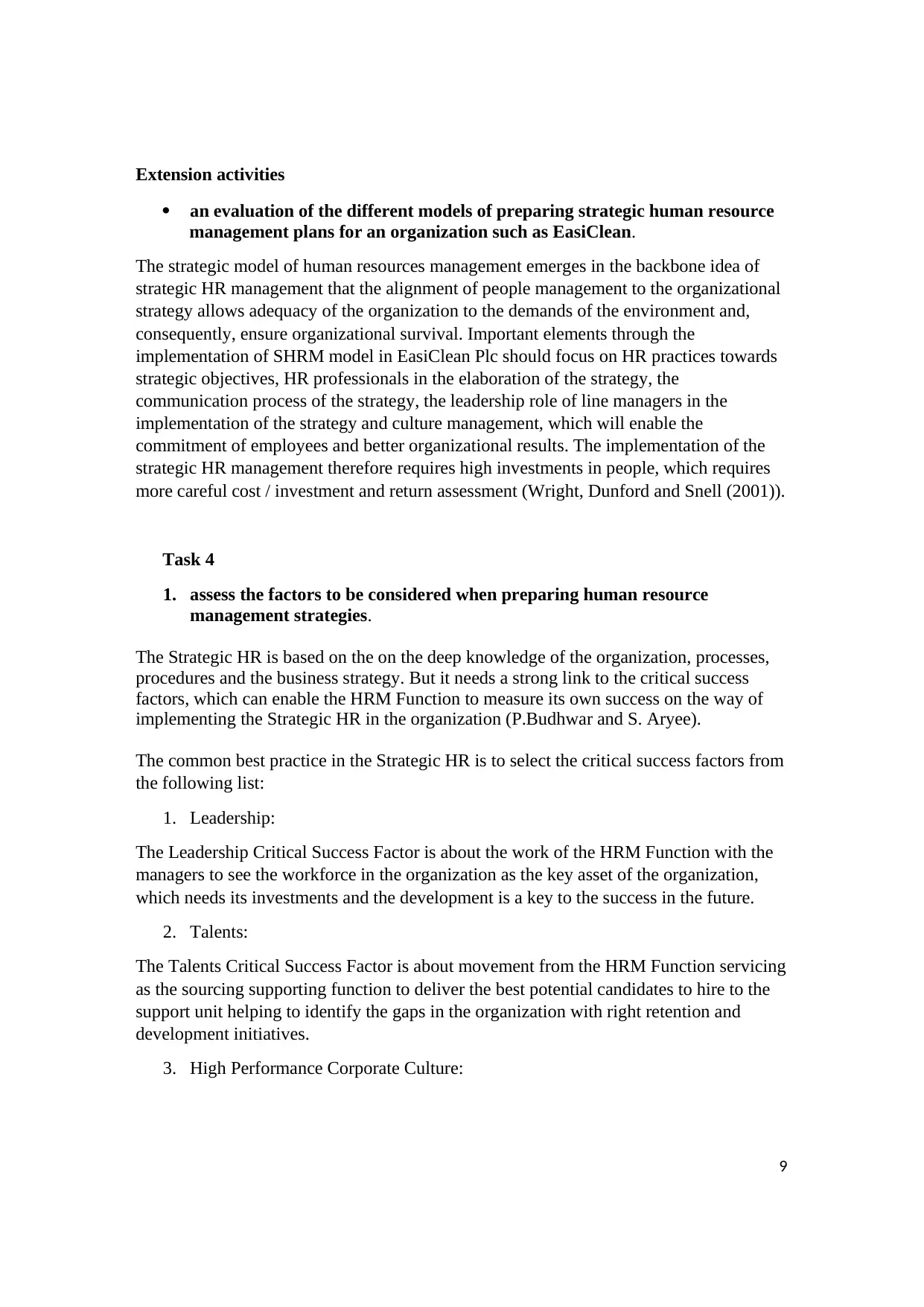
9
Extension activities
an evaluation of the different models of preparing strategic human resource
management plans for an organization such as EasiClean.
The strategic model of human resources management emerges in the backbone idea of
strategic HR management that the alignment of people management to the organizational
strategy allows adequacy of the organization to the demands of the environment and,
consequently, ensure organizational survival. Important elements through the
implementation of SHRM model in EasiClean Plc should focus on HR practices towards
strategic objectives, HR professionals in the elaboration of the strategy, the
communication process of the strategy, the leadership role of line managers in the
implementation of the strategy and culture management, which will enable the
commitment of employees and better organizational results. The implementation of the
strategic HR management therefore requires high investments in people, which requires
more careful cost / investment and return assessment (Wright, Dunford and Snell (2001)).
Task 4
1. assess the factors to be considered when preparing human resource
management strategies.
The Strategic HR is based on the on the deep knowledge of the organization, processes,
procedures and the business strategy. But it needs a strong link to the critical success
factors, which can enable the HRM Function to measure its own success on the way of
implementing the Strategic HR in the organization (P.Budhwar and S. Aryee).
The common best practice in the Strategic HR is to select the critical success factors from
the following list:
1. Leadership:
The Leadership Critical Success Factor is about the work of the HRM Function with the
managers to see the workforce in the organization as the key asset of the organization,
which needs its investments and the development is a key to the success in the future.
2. Talents:
The Talents Critical Success Factor is about movement from the HRM Function servicing
as the sourcing supporting function to deliver the best potential candidates to hire to the
support unit helping to identify the gaps in the organization with right retention and
development initiatives.
3. High Performance Corporate Culture:
Extension activities
an evaluation of the different models of preparing strategic human resource
management plans for an organization such as EasiClean.
The strategic model of human resources management emerges in the backbone idea of
strategic HR management that the alignment of people management to the organizational
strategy allows adequacy of the organization to the demands of the environment and,
consequently, ensure organizational survival. Important elements through the
implementation of SHRM model in EasiClean Plc should focus on HR practices towards
strategic objectives, HR professionals in the elaboration of the strategy, the
communication process of the strategy, the leadership role of line managers in the
implementation of the strategy and culture management, which will enable the
commitment of employees and better organizational results. The implementation of the
strategic HR management therefore requires high investments in people, which requires
more careful cost / investment and return assessment (Wright, Dunford and Snell (2001)).
Task 4
1. assess the factors to be considered when preparing human resource
management strategies.
The Strategic HR is based on the on the deep knowledge of the organization, processes,
procedures and the business strategy. But it needs a strong link to the critical success
factors, which can enable the HRM Function to measure its own success on the way of
implementing the Strategic HR in the organization (P.Budhwar and S. Aryee).
The common best practice in the Strategic HR is to select the critical success factors from
the following list:
1. Leadership:
The Leadership Critical Success Factor is about the work of the HRM Function with the
managers to see the workforce in the organization as the key asset of the organization,
which needs its investments and the development is a key to the success in the future.
2. Talents:
The Talents Critical Success Factor is about movement from the HRM Function servicing
as the sourcing supporting function to deliver the best potential candidates to hire to the
support unit helping to identify the gaps in the organization with right retention and
development initiatives.
3. High Performance Corporate Culture:
Secure Best Marks with AI Grader
Need help grading? Try our AI Grader for instant feedback on your assignments.
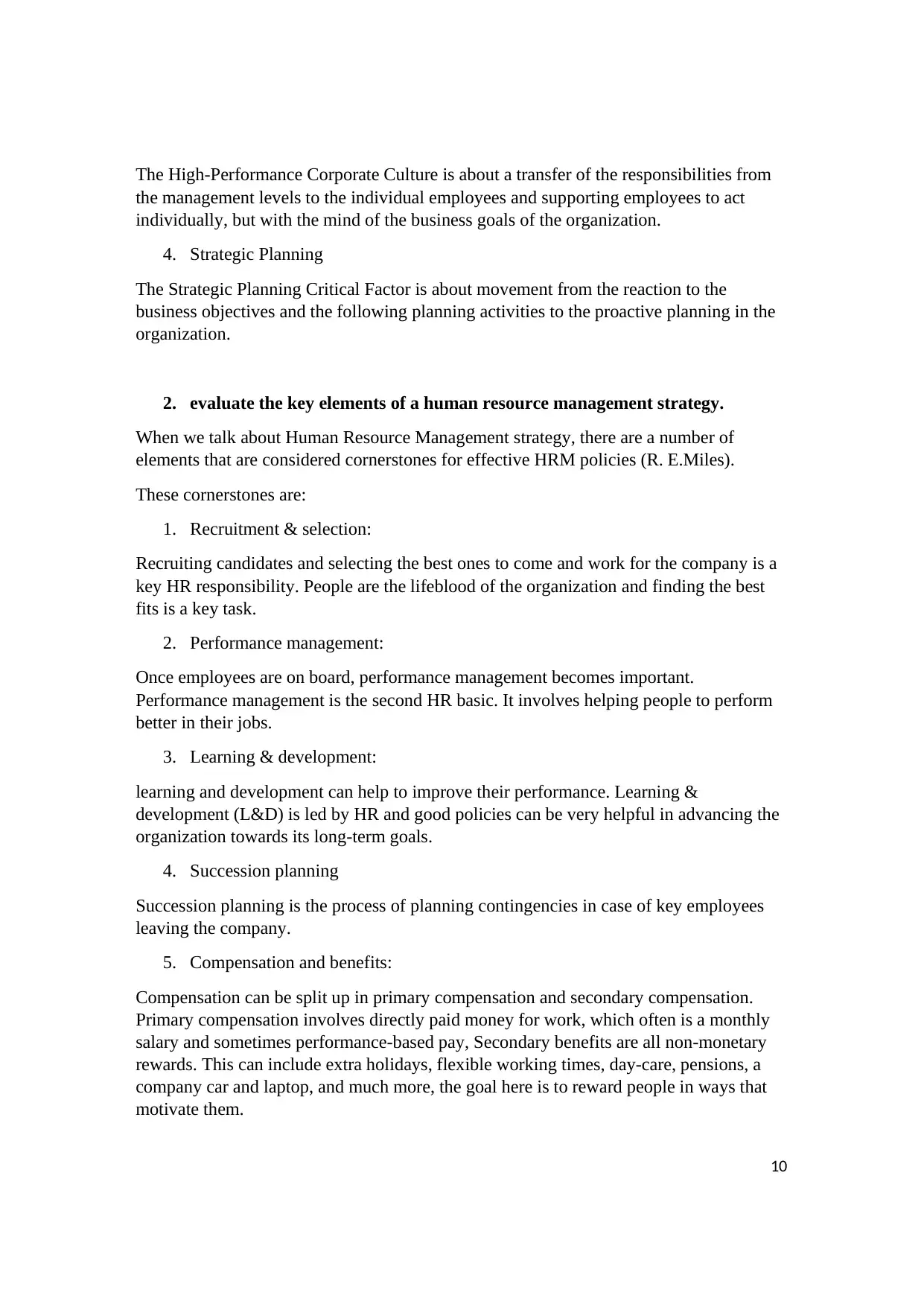
10
The High-Performance Corporate Culture is about a transfer of the responsibilities from
the management levels to the individual employees and supporting employees to act
individually, but with the mind of the business goals of the organization.
4. Strategic Planning
The Strategic Planning Critical Factor is about movement from the reaction to the
business objectives and the following planning activities to the proactive planning in the
organization.
2. evaluate the key elements of a human resource management strategy.
When we talk about Human Resource Management strategy, there are a number of
elements that are considered cornerstones for effective HRM policies (R. E.Miles).
These cornerstones are:
1. Recruitment & selection:
Recruiting candidates and selecting the best ones to come and work for the company is a
key HR responsibility. People are the lifeblood of the organization and finding the best
fits is a key task.
2. Performance management:
Once employees are on board, performance management becomes important.
Performance management is the second HR basic. It involves helping people to perform
better in their jobs.
3. Learning & development:
learning and development can help to improve their performance. Learning &
development (L&D) is led by HR and good policies can be very helpful in advancing the
organization towards its long-term goals.
4. Succession planning
Succession planning is the process of planning contingencies in case of key employees
leaving the company.
5. Compensation and benefits:
Compensation can be split up in primary compensation and secondary compensation.
Primary compensation involves directly paid money for work, which often is a monthly
salary and sometimes performance-based pay, Secondary benefits are all non-monetary
rewards. This can include extra holidays, flexible working times, day-care, pensions, a
company car and laptop, and much more, the goal here is to reward people in ways that
motivate them.
The High-Performance Corporate Culture is about a transfer of the responsibilities from
the management levels to the individual employees and supporting employees to act
individually, but with the mind of the business goals of the organization.
4. Strategic Planning
The Strategic Planning Critical Factor is about movement from the reaction to the
business objectives and the following planning activities to the proactive planning in the
organization.
2. evaluate the key elements of a human resource management strategy.
When we talk about Human Resource Management strategy, there are a number of
elements that are considered cornerstones for effective HRM policies (R. E.Miles).
These cornerstones are:
1. Recruitment & selection:
Recruiting candidates and selecting the best ones to come and work for the company is a
key HR responsibility. People are the lifeblood of the organization and finding the best
fits is a key task.
2. Performance management:
Once employees are on board, performance management becomes important.
Performance management is the second HR basic. It involves helping people to perform
better in their jobs.
3. Learning & development:
learning and development can help to improve their performance. Learning &
development (L&D) is led by HR and good policies can be very helpful in advancing the
organization towards its long-term goals.
4. Succession planning
Succession planning is the process of planning contingencies in case of key employees
leaving the company.
5. Compensation and benefits:
Compensation can be split up in primary compensation and secondary compensation.
Primary compensation involves directly paid money for work, which often is a monthly
salary and sometimes performance-based pay, Secondary benefits are all non-monetary
rewards. This can include extra holidays, flexible working times, day-care, pensions, a
company car and laptop, and much more, the goal here is to reward people in ways that
motivate them.
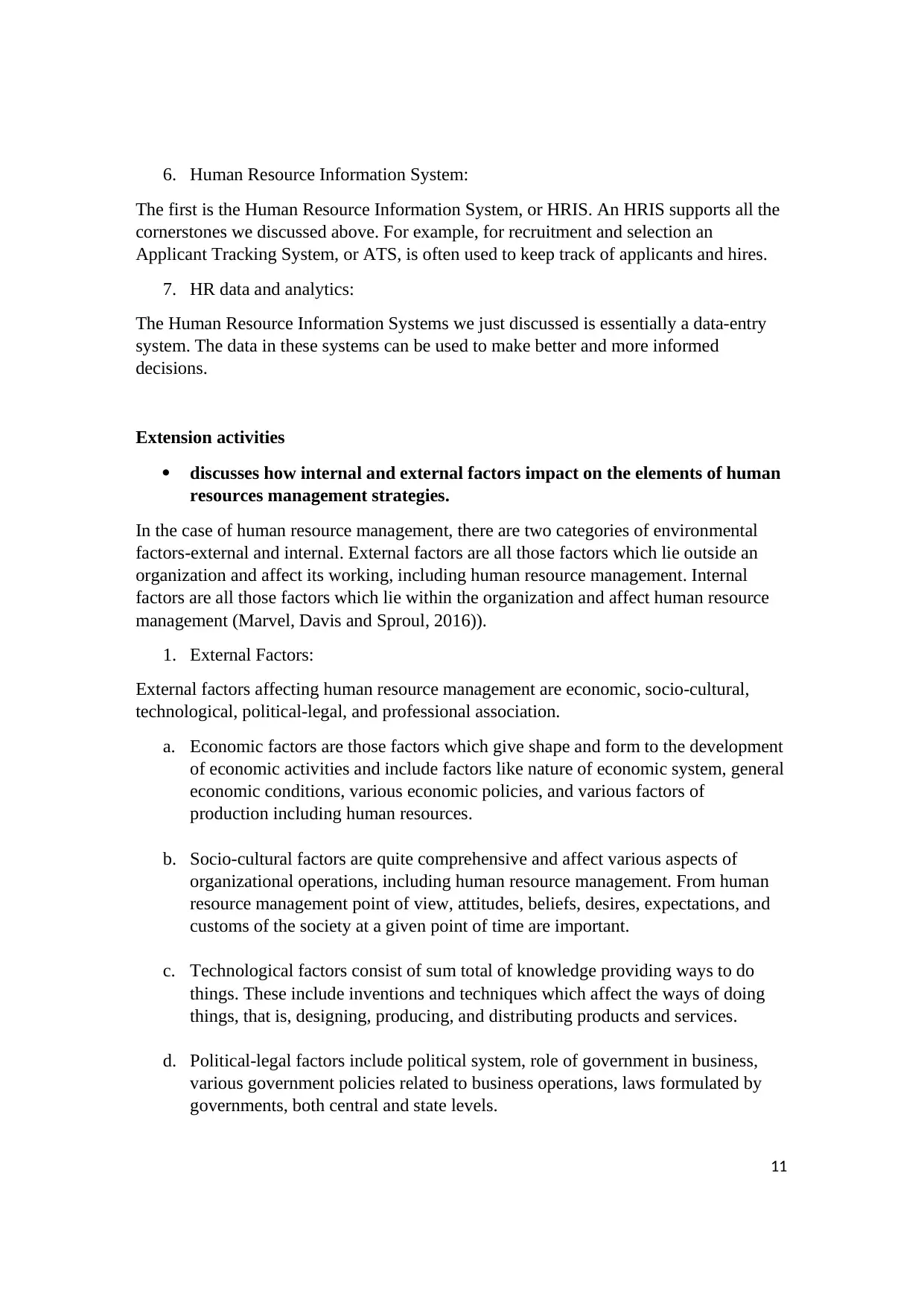
11
6. Human Resource Information System:
The first is the Human Resource Information System, or HRIS. An HRIS supports all the
cornerstones we discussed above. For example, for recruitment and selection an
Applicant Tracking System, or ATS, is often used to keep track of applicants and hires.
7. HR data and analytics:
The Human Resource Information Systems we just discussed is essentially a data-entry
system. The data in these systems can be used to make better and more informed
decisions.
Extension activities
discusses how internal and external factors impact on the elements of human
resources management strategies.
In the case of human resource management, there are two categories of environmental
factors-external and internal. External factors are all those factors which lie outside an
organization and affect its working, including human resource management. Internal
factors are all those factors which lie within the organization and affect human resource
management (Marvel, Davis and Sproul, 2016)).
1. External Factors:
External factors affecting human resource management are economic, socio-cultural,
technological, political-legal, and professional association.
a. Economic factors are those factors which give shape and form to the development
of economic activities and include factors like nature of economic system, general
economic conditions, various economic policies, and various factors of
production including human resources.
b. Socio-cultural factors are quite comprehensive and affect various aspects of
organizational operations, including human resource management. From human
resource management point of view, attitudes, beliefs, desires, expectations, and
customs of the society at a given point of time are important.
c. Technological factors consist of sum total of knowledge providing ways to do
things. These include inventions and techniques which affect the ways of doing
things, that is, designing, producing, and distributing products and services.
d. Political-legal factors include political system, role of government in business,
various government policies related to business operations, laws formulated by
governments, both central and state levels.
6. Human Resource Information System:
The first is the Human Resource Information System, or HRIS. An HRIS supports all the
cornerstones we discussed above. For example, for recruitment and selection an
Applicant Tracking System, or ATS, is often used to keep track of applicants and hires.
7. HR data and analytics:
The Human Resource Information Systems we just discussed is essentially a data-entry
system. The data in these systems can be used to make better and more informed
decisions.
Extension activities
discusses how internal and external factors impact on the elements of human
resources management strategies.
In the case of human resource management, there are two categories of environmental
factors-external and internal. External factors are all those factors which lie outside an
organization and affect its working, including human resource management. Internal
factors are all those factors which lie within the organization and affect human resource
management (Marvel, Davis and Sproul, 2016)).
1. External Factors:
External factors affecting human resource management are economic, socio-cultural,
technological, political-legal, and professional association.
a. Economic factors are those factors which give shape and form to the development
of economic activities and include factors like nature of economic system, general
economic conditions, various economic policies, and various factors of
production including human resources.
b. Socio-cultural factors are quite comprehensive and affect various aspects of
organizational operations, including human resource management. From human
resource management point of view, attitudes, beliefs, desires, expectations, and
customs of the society at a given point of time are important.
c. Technological factors consist of sum total of knowledge providing ways to do
things. These include inventions and techniques which affect the ways of doing
things, that is, designing, producing, and distributing products and services.
d. Political-legal factors include political system, role of government in business,
various government policies related to business operations, laws formulated by
governments, both central and state levels.
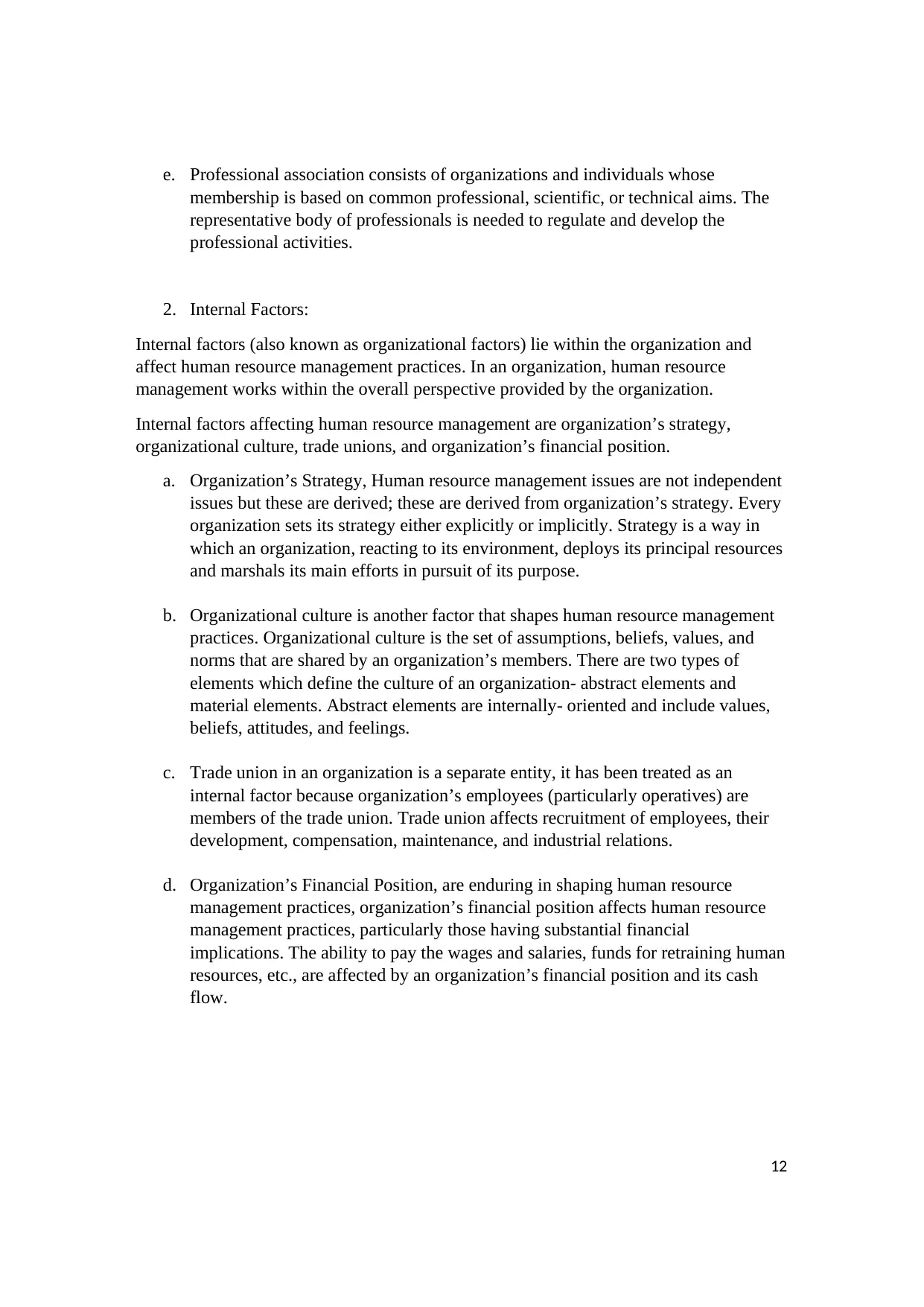
12
e. Professional association consists of organizations and individuals whose
membership is based on common professional, scientific, or technical aims. The
representative body of professionals is needed to regulate and develop the
professional activities.
2. Internal Factors:
Internal factors (also known as organizational factors) lie within the organization and
affect human resource management practices. In an organization, human resource
management works within the overall perspective provided by the organization.
Internal factors affecting human resource management are organization’s strategy,
organizational culture, trade unions, and organization’s financial position.
a. Organization’s Strategy, Human resource management issues are not independent
issues but these are derived; these are derived from organization’s strategy. Every
organization sets its strategy either explicitly or implicitly. Strategy is a way in
which an organization, reacting to its environment, deploys its principal resources
and marshals its main efforts in pursuit of its purpose.
b. Organizational culture is another factor that shapes human resource management
practices. Organizational culture is the set of assumptions, beliefs, values, and
norms that are shared by an organization’s members. There are two types of
elements which define the culture of an organization- abstract elements and
material elements. Abstract elements are internally- oriented and include values,
beliefs, attitudes, and feelings.
c. Trade union in an organization is a separate entity, it has been treated as an
internal factor because organization’s employees (particularly operatives) are
members of the trade union. Trade union affects recruitment of employees, their
development, compensation, maintenance, and industrial relations.
d. Organization’s Financial Position, are enduring in shaping human resource
management practices, organization’s financial position affects human resource
management practices, particularly those having substantial financial
implications. The ability to pay the wages and salaries, funds for retraining human
resources, etc., are affected by an organization’s financial position and its cash
flow.
e. Professional association consists of organizations and individuals whose
membership is based on common professional, scientific, or technical aims. The
representative body of professionals is needed to regulate and develop the
professional activities.
2. Internal Factors:
Internal factors (also known as organizational factors) lie within the organization and
affect human resource management practices. In an organization, human resource
management works within the overall perspective provided by the organization.
Internal factors affecting human resource management are organization’s strategy,
organizational culture, trade unions, and organization’s financial position.
a. Organization’s Strategy, Human resource management issues are not independent
issues but these are derived; these are derived from organization’s strategy. Every
organization sets its strategy either explicitly or implicitly. Strategy is a way in
which an organization, reacting to its environment, deploys its principal resources
and marshals its main efforts in pursuit of its purpose.
b. Organizational culture is another factor that shapes human resource management
practices. Organizational culture is the set of assumptions, beliefs, values, and
norms that are shared by an organization’s members. There are two types of
elements which define the culture of an organization- abstract elements and
material elements. Abstract elements are internally- oriented and include values,
beliefs, attitudes, and feelings.
c. Trade union in an organization is a separate entity, it has been treated as an
internal factor because organization’s employees (particularly operatives) are
members of the trade union. Trade union affects recruitment of employees, their
development, compensation, maintenance, and industrial relations.
d. Organization’s Financial Position, are enduring in shaping human resource
management practices, organization’s financial position affects human resource
management practices, particularly those having substantial financial
implications. The ability to pay the wages and salaries, funds for retraining human
resources, etc., are affected by an organization’s financial position and its cash
flow.
Paraphrase This Document
Need a fresh take? Get an instant paraphrase of this document with our AI Paraphraser
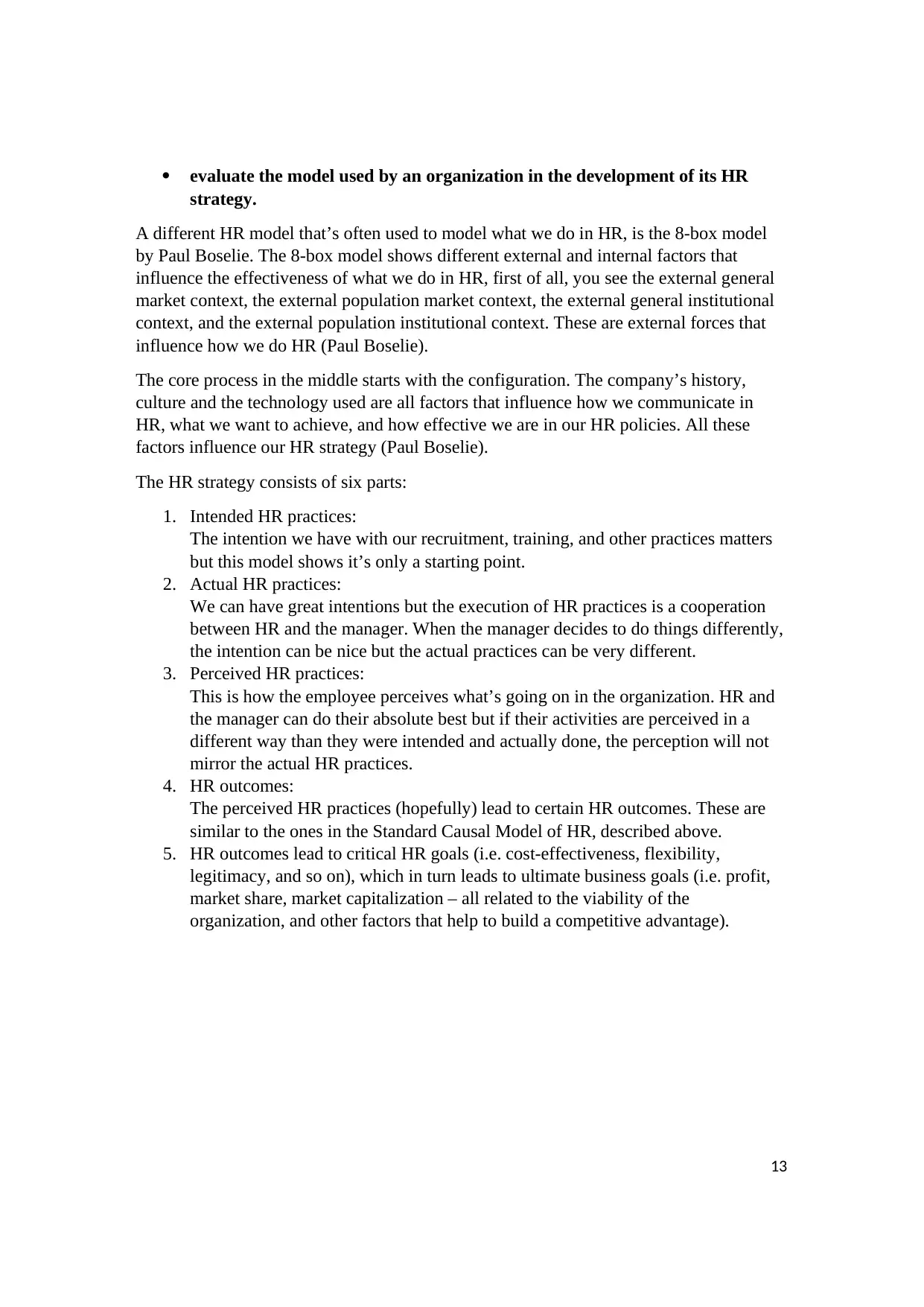
13
evaluate the model used by an organization in the development of its HR
strategy.
A different HR model that’s often used to model what we do in HR, is the 8-box model
by Paul Boselie. The 8-box model shows different external and internal factors that
influence the effectiveness of what we do in HR, first of all, you see the external general
market context, the external population market context, the external general institutional
context, and the external population institutional context. These are external forces that
influence how we do HR (Paul Boselie).
The core process in the middle starts with the configuration. The company’s history,
culture and the technology used are all factors that influence how we communicate in
HR, what we want to achieve, and how effective we are in our HR policies. All these
factors influence our HR strategy (Paul Boselie).
The HR strategy consists of six parts:
1. Intended HR practices:
The intention we have with our recruitment, training, and other practices matters
but this model shows it’s only a starting point.
2. Actual HR practices:
We can have great intentions but the execution of HR practices is a cooperation
between HR and the manager. When the manager decides to do things differently,
the intention can be nice but the actual practices can be very different.
3. Perceived HR practices:
This is how the employee perceives what’s going on in the organization. HR and
the manager can do their absolute best but if their activities are perceived in a
different way than they were intended and actually done, the perception will not
mirror the actual HR practices.
4. HR outcomes:
The perceived HR practices (hopefully) lead to certain HR outcomes. These are
similar to the ones in the Standard Causal Model of HR, described above.
5. HR outcomes lead to critical HR goals (i.e. cost-effectiveness, flexibility,
legitimacy, and so on), which in turn leads to ultimate business goals (i.e. profit,
market share, market capitalization – all related to the viability of the
organization, and other factors that help to build a competitive advantage).
evaluate the model used by an organization in the development of its HR
strategy.
A different HR model that’s often used to model what we do in HR, is the 8-box model
by Paul Boselie. The 8-box model shows different external and internal factors that
influence the effectiveness of what we do in HR, first of all, you see the external general
market context, the external population market context, the external general institutional
context, and the external population institutional context. These are external forces that
influence how we do HR (Paul Boselie).
The core process in the middle starts with the configuration. The company’s history,
culture and the technology used are all factors that influence how we communicate in
HR, what we want to achieve, and how effective we are in our HR policies. All these
factors influence our HR strategy (Paul Boselie).
The HR strategy consists of six parts:
1. Intended HR practices:
The intention we have with our recruitment, training, and other practices matters
but this model shows it’s only a starting point.
2. Actual HR practices:
We can have great intentions but the execution of HR practices is a cooperation
between HR and the manager. When the manager decides to do things differently,
the intention can be nice but the actual practices can be very different.
3. Perceived HR practices:
This is how the employee perceives what’s going on in the organization. HR and
the manager can do their absolute best but if their activities are perceived in a
different way than they were intended and actually done, the perception will not
mirror the actual HR practices.
4. HR outcomes:
The perceived HR practices (hopefully) lead to certain HR outcomes. These are
similar to the ones in the Standard Causal Model of HR, described above.
5. HR outcomes lead to critical HR goals (i.e. cost-effectiveness, flexibility,
legitimacy, and so on), which in turn leads to ultimate business goals (i.e. profit,
market share, market capitalization – all related to the viability of the
organization, and other factors that help to build a competitive advantage).
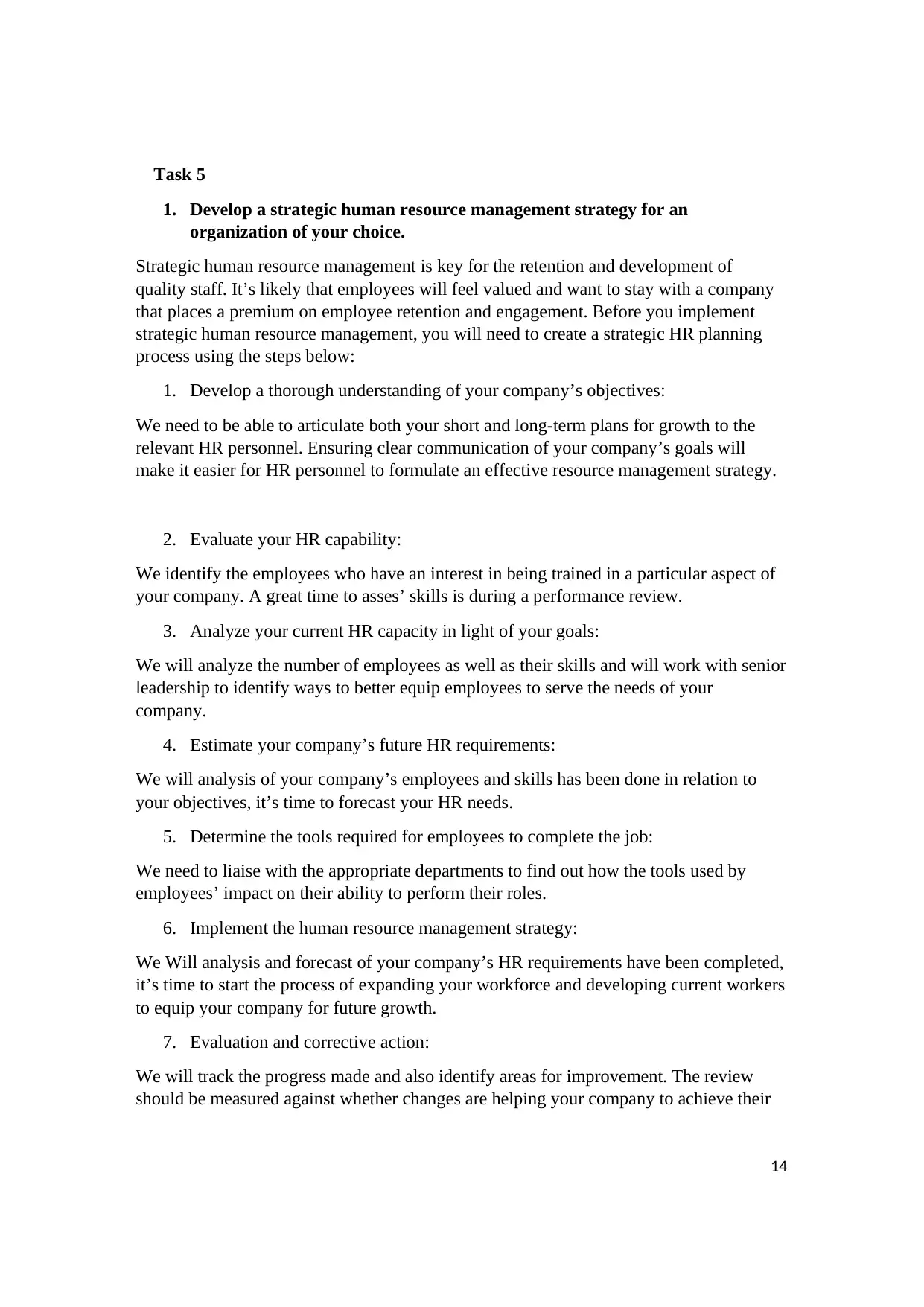
14
Task 5
1. Develop a strategic human resource management strategy for an
organization of your choice.
Strategic human resource management is key for the retention and development of
quality staff. It’s likely that employees will feel valued and want to stay with a company
that places a premium on employee retention and engagement. Before you implement
strategic human resource management, you will need to create a strategic HR planning
process using the steps below:
1. Develop a thorough understanding of your company’s objectives:
We need to be able to articulate both your short and long-term plans for growth to the
relevant HR personnel. Ensuring clear communication of your company’s goals will
make it easier for HR personnel to formulate an effective resource management strategy.
2. Evaluate your HR capability:
We identify the employees who have an interest in being trained in a particular aspect of
your company. A great time to asses’ skills is during a performance review.
3. Analyze your current HR capacity in light of your goals:
We will analyze the number of employees as well as their skills and will work with senior
leadership to identify ways to better equip employees to serve the needs of your
company.
4. Estimate your company’s future HR requirements:
We will analysis of your company’s employees and skills has been done in relation to
your objectives, it’s time to forecast your HR needs.
5. Determine the tools required for employees to complete the job:
We need to liaise with the appropriate departments to find out how the tools used by
employees’ impact on their ability to perform their roles.
6. Implement the human resource management strategy:
We Will analysis and forecast of your company’s HR requirements have been completed,
it’s time to start the process of expanding your workforce and developing current workers
to equip your company for future growth.
7. Evaluation and corrective action:
We will track the progress made and also identify areas for improvement. The review
should be measured against whether changes are helping your company to achieve their
Task 5
1. Develop a strategic human resource management strategy for an
organization of your choice.
Strategic human resource management is key for the retention and development of
quality staff. It’s likely that employees will feel valued and want to stay with a company
that places a premium on employee retention and engagement. Before you implement
strategic human resource management, you will need to create a strategic HR planning
process using the steps below:
1. Develop a thorough understanding of your company’s objectives:
We need to be able to articulate both your short and long-term plans for growth to the
relevant HR personnel. Ensuring clear communication of your company’s goals will
make it easier for HR personnel to formulate an effective resource management strategy.
2. Evaluate your HR capability:
We identify the employees who have an interest in being trained in a particular aspect of
your company. A great time to asses’ skills is during a performance review.
3. Analyze your current HR capacity in light of your goals:
We will analyze the number of employees as well as their skills and will work with senior
leadership to identify ways to better equip employees to serve the needs of your
company.
4. Estimate your company’s future HR requirements:
We will analysis of your company’s employees and skills has been done in relation to
your objectives, it’s time to forecast your HR needs.
5. Determine the tools required for employees to complete the job:
We need to liaise with the appropriate departments to find out how the tools used by
employees’ impact on their ability to perform their roles.
6. Implement the human resource management strategy:
We Will analysis and forecast of your company’s HR requirements have been completed,
it’s time to start the process of expanding your workforce and developing current workers
to equip your company for future growth.
7. Evaluation and corrective action:
We will track the progress made and also identify areas for improvement. The review
should be measured against whether changes are helping your company to achieve their
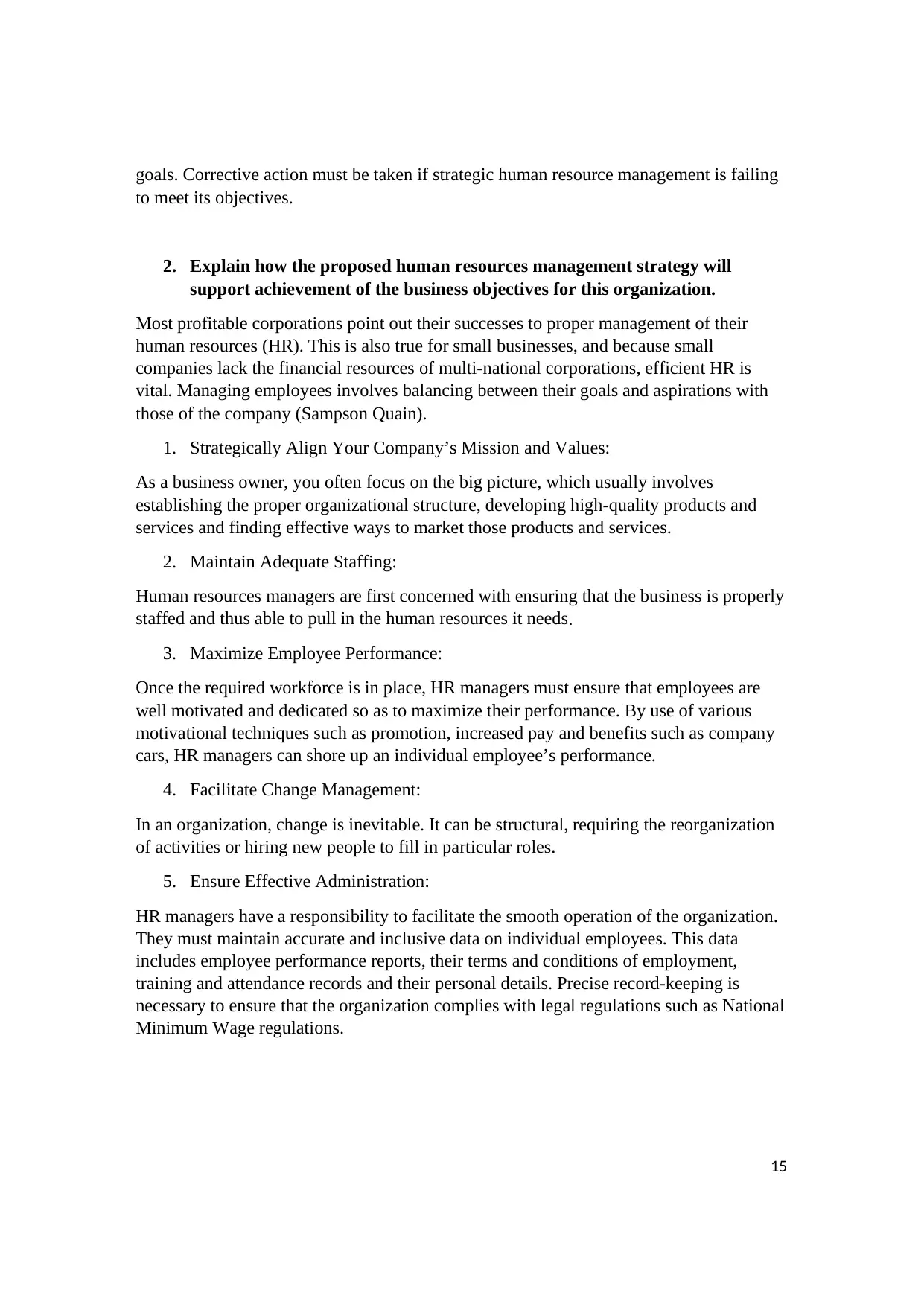
15
goals. Corrective action must be taken if strategic human resource management is failing
to meet its objectives.
2. Explain how the proposed human resources management strategy will
support achievement of the business objectives for this organization.
Most profitable corporations point out their successes to proper management of their
human resources (HR). This is also true for small businesses, and because small
companies lack the financial resources of multi-national corporations, efficient HR is
vital. Managing employees involves balancing between their goals and aspirations with
those of the company (Sampson Quain).
1. Strategically Align Your Company’s Mission and Values:
As a business owner, you often focus on the big picture, which usually involves
establishing the proper organizational structure, developing high-quality products and
services and finding effective ways to market those products and services.
2. Maintain Adequate Staffing:
Human resources managers are first concerned with ensuring that the business is properly
staffed and thus able to pull in the human resources it needs.
3. Maximize Employee Performance:
Once the required workforce is in place, HR managers must ensure that employees are
well motivated and dedicated so as to maximize their performance. By use of various
motivational techniques such as promotion, increased pay and benefits such as company
cars, HR managers can shore up an individual employee’s performance.
4. Facilitate Change Management:
In an organization, change is inevitable. It can be structural, requiring the reorganization
of activities or hiring new people to fill in particular roles.
5. Ensure Effective Administration:
HR managers have a responsibility to facilitate the smooth operation of the organization.
They must maintain accurate and inclusive data on individual employees. This data
includes employee performance reports, their terms and conditions of employment,
training and attendance records and their personal details. Precise record-keeping is
necessary to ensure that the organization complies with legal regulations such as National
Minimum Wage regulations.
goals. Corrective action must be taken if strategic human resource management is failing
to meet its objectives.
2. Explain how the proposed human resources management strategy will
support achievement of the business objectives for this organization.
Most profitable corporations point out their successes to proper management of their
human resources (HR). This is also true for small businesses, and because small
companies lack the financial resources of multi-national corporations, efficient HR is
vital. Managing employees involves balancing between their goals and aspirations with
those of the company (Sampson Quain).
1. Strategically Align Your Company’s Mission and Values:
As a business owner, you often focus on the big picture, which usually involves
establishing the proper organizational structure, developing high-quality products and
services and finding effective ways to market those products and services.
2. Maintain Adequate Staffing:
Human resources managers are first concerned with ensuring that the business is properly
staffed and thus able to pull in the human resources it needs.
3. Maximize Employee Performance:
Once the required workforce is in place, HR managers must ensure that employees are
well motivated and dedicated so as to maximize their performance. By use of various
motivational techniques such as promotion, increased pay and benefits such as company
cars, HR managers can shore up an individual employee’s performance.
4. Facilitate Change Management:
In an organization, change is inevitable. It can be structural, requiring the reorganization
of activities or hiring new people to fill in particular roles.
5. Ensure Effective Administration:
HR managers have a responsibility to facilitate the smooth operation of the organization.
They must maintain accurate and inclusive data on individual employees. This data
includes employee performance reports, their terms and conditions of employment,
training and attendance records and their personal details. Precise record-keeping is
necessary to ensure that the organization complies with legal regulations such as National
Minimum Wage regulations.
Secure Best Marks with AI Grader
Need help grading? Try our AI Grader for instant feedback on your assignments.
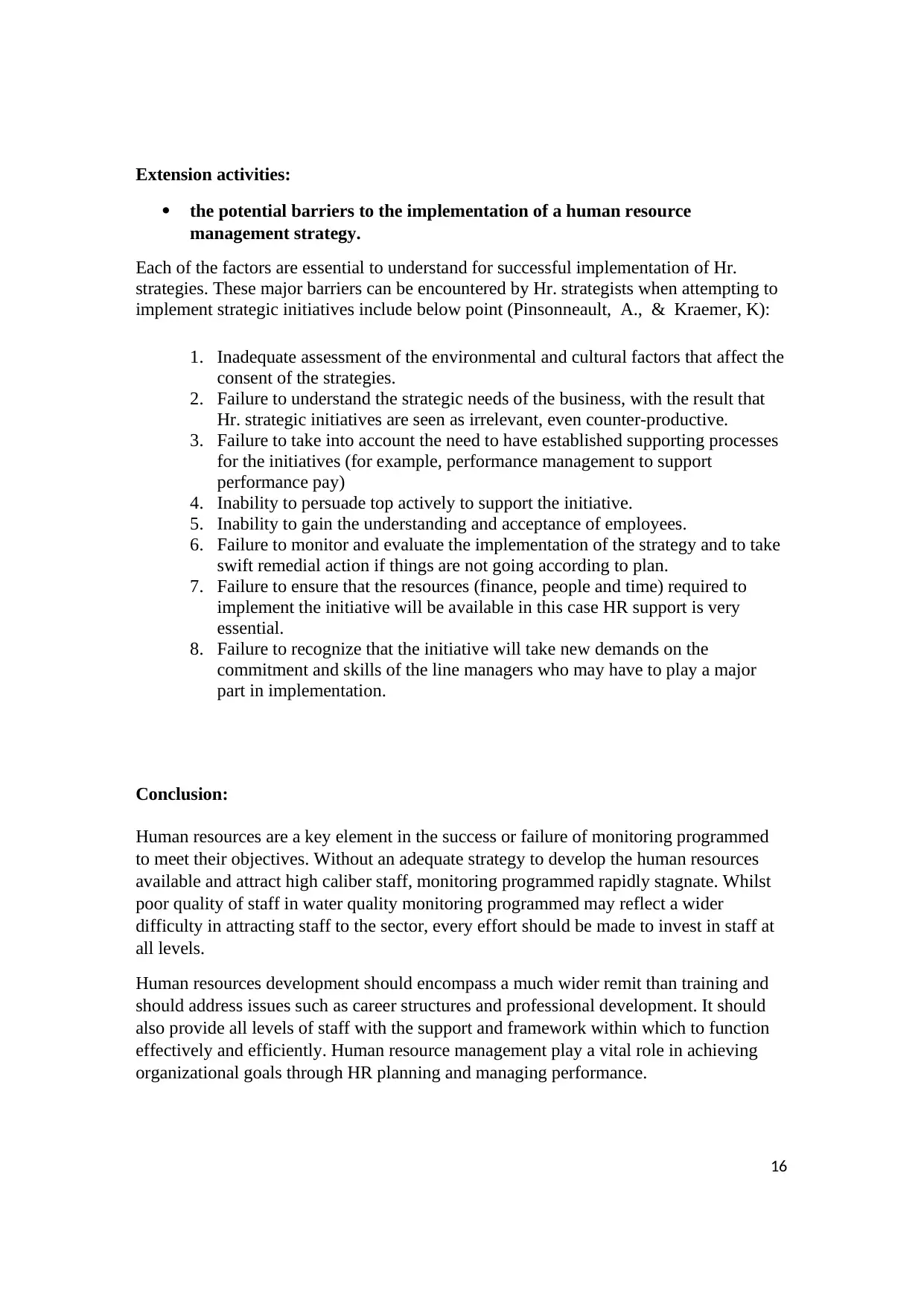
16
Extension activities:
the potential barriers to the implementation of a human resource
management strategy.
Each of the factors are essential to understand for successful implementation of Hr.
strategies. These major barriers can be encountered by Hr. strategists when attempting to
implement strategic initiatives include below point (Pinsonneault, A., & Kraemer, K):
1. Inadequate assessment of the environmental and cultural factors that affect the
consent of the strategies.
2. Failure to understand the strategic needs of the business, with the result that
Hr. strategic initiatives are seen as irrelevant, even counter-productive.
3. Failure to take into account the need to have established supporting processes
for the initiatives (for example, performance management to support
performance pay)
4. Inability to persuade top actively to support the initiative.
5. Inability to gain the understanding and acceptance of employees.
6. Failure to monitor and evaluate the implementation of the strategy and to take
swift remedial action if things are not going according to plan.
7. Failure to ensure that the resources (finance, people and time) required to
implement the initiative will be available in this case HR support is very
essential.
8. Failure to recognize that the initiative will take new demands on the
commitment and skills of the line managers who may have to play a major
part in implementation.
Conclusion:
Human resources are a key element in the success or failure of monitoring programmed
to meet their objectives. Without an adequate strategy to develop the human resources
available and attract high caliber staff, monitoring programmed rapidly stagnate. Whilst
poor quality of staff in water quality monitoring programmed may reflect a wider
difficulty in attracting staff to the sector, every effort should be made to invest in staff at
all levels.
Human resources development should encompass a much wider remit than training and
should address issues such as career structures and professional development. It should
also provide all levels of staff with the support and framework within which to function
effectively and efficiently. Human resource management play a vital role in achieving
organizational goals through HR planning and managing performance.
Extension activities:
the potential barriers to the implementation of a human resource
management strategy.
Each of the factors are essential to understand for successful implementation of Hr.
strategies. These major barriers can be encountered by Hr. strategists when attempting to
implement strategic initiatives include below point (Pinsonneault, A., & Kraemer, K):
1. Inadequate assessment of the environmental and cultural factors that affect the
consent of the strategies.
2. Failure to understand the strategic needs of the business, with the result that
Hr. strategic initiatives are seen as irrelevant, even counter-productive.
3. Failure to take into account the need to have established supporting processes
for the initiatives (for example, performance management to support
performance pay)
4. Inability to persuade top actively to support the initiative.
5. Inability to gain the understanding and acceptance of employees.
6. Failure to monitor and evaluate the implementation of the strategy and to take
swift remedial action if things are not going according to plan.
7. Failure to ensure that the resources (finance, people and time) required to
implement the initiative will be available in this case HR support is very
essential.
8. Failure to recognize that the initiative will take new demands on the
commitment and skills of the line managers who may have to play a major
part in implementation.
Conclusion:
Human resources are a key element in the success or failure of monitoring programmed
to meet their objectives. Without an adequate strategy to develop the human resources
available and attract high caliber staff, monitoring programmed rapidly stagnate. Whilst
poor quality of staff in water quality monitoring programmed may reflect a wider
difficulty in attracting staff to the sector, every effort should be made to invest in staff at
all levels.
Human resources development should encompass a much wider remit than training and
should address issues such as career structures and professional development. It should
also provide all levels of staff with the support and framework within which to function
effectively and efficiently. Human resource management play a vital role in achieving
organizational goals through HR planning and managing performance.
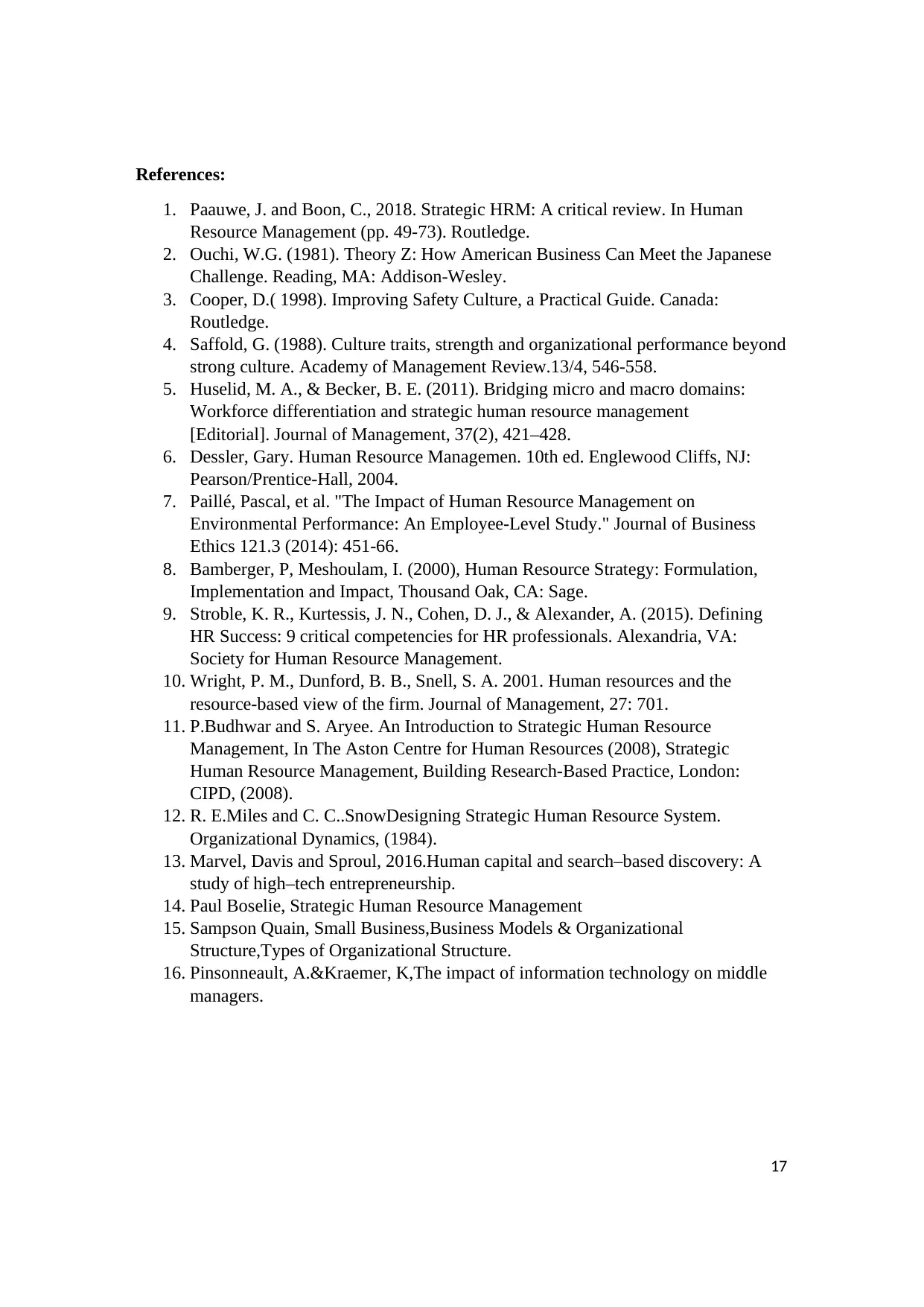
17
References:
1. Paauwe, J. and Boon, C., 2018. Strategic HRM: A critical review. In Human
Resource Management (pp. 49-73). Routledge.
2. Ouchi, W.G. (1981). Theory Z: How American Business Can Meet the Japanese
Challenge. Reading, MA: Addison-Wesley.
3. Cooper, D.( 1998). Improving Safety Culture, a Practical Guide. Canada:
Routledge.
4. Saffold, G. (1988). Culture traits, strength and organizational performance beyond
strong culture. Academy of Management Review.13/4, 546-558.
5. Huselid, M. A., & Becker, B. E. (2011). Bridging micro and macro domains:
Workforce differentiation and strategic human resource management
[Editorial]. Journal of Management, 37(2), 421–428.
6. Dessler, Gary. Human Resource Managemen. 10th ed. Englewood Cliffs, NJ:
Pearson/Prentice-Hall, 2004.
7. Paillé, Pascal, et al. "The Impact of Human Resource Management on
Environmental Performance: An Employee-Level Study." Journal of Business
Ethics 121.3 (2014): 451-66.
8. Bamberger, P, Meshoulam, I. (2000), Human Resource Strategy: Formulation,
Implementation and Impact, Thousand Oak, CA: Sage.
9. Stroble, K. R., Kurtessis, J. N., Cohen, D. J., & Alexander, A. (2015). Defining
HR Success: 9 critical competencies for HR professionals. Alexandria, VA:
Society for Human Resource Management.
10. Wright, P. M., Dunford, B. B., Snell, S. A. 2001. Human resources and the
resource-based view of the firm. Journal of Management, 27: 701.
11. P.Budhwar and S. Aryee. An Introduction to Strategic Human Resource
Management, In The Aston Centre for Human Resources (2008), Strategic
Human Resource Management, Building Research-Based Practice, London:
CIPD, (2008).
12. R. E.Miles and C. C..SnowDesigning Strategic Human Resource System.
Organizational Dynamics, (1984).
13. Marvel, Davis and Sproul, 2016.Human capital and search–based discovery: A
study of high–tech entrepreneurship.
14. Paul Boselie, Strategic Human Resource Management
15. Sampson Quain, Small Business,Business Models & Organizational
Structure,Types of Organizational Structure.
16. Pinsonneault, A.&Kraemer, K,The impact of information technology on middle
managers.
References:
1. Paauwe, J. and Boon, C., 2018. Strategic HRM: A critical review. In Human
Resource Management (pp. 49-73). Routledge.
2. Ouchi, W.G. (1981). Theory Z: How American Business Can Meet the Japanese
Challenge. Reading, MA: Addison-Wesley.
3. Cooper, D.( 1998). Improving Safety Culture, a Practical Guide. Canada:
Routledge.
4. Saffold, G. (1988). Culture traits, strength and organizational performance beyond
strong culture. Academy of Management Review.13/4, 546-558.
5. Huselid, M. A., & Becker, B. E. (2011). Bridging micro and macro domains:
Workforce differentiation and strategic human resource management
[Editorial]. Journal of Management, 37(2), 421–428.
6. Dessler, Gary. Human Resource Managemen. 10th ed. Englewood Cliffs, NJ:
Pearson/Prentice-Hall, 2004.
7. Paillé, Pascal, et al. "The Impact of Human Resource Management on
Environmental Performance: An Employee-Level Study." Journal of Business
Ethics 121.3 (2014): 451-66.
8. Bamberger, P, Meshoulam, I. (2000), Human Resource Strategy: Formulation,
Implementation and Impact, Thousand Oak, CA: Sage.
9. Stroble, K. R., Kurtessis, J. N., Cohen, D. J., & Alexander, A. (2015). Defining
HR Success: 9 critical competencies for HR professionals. Alexandria, VA:
Society for Human Resource Management.
10. Wright, P. M., Dunford, B. B., Snell, S. A. 2001. Human resources and the
resource-based view of the firm. Journal of Management, 27: 701.
11. P.Budhwar and S. Aryee. An Introduction to Strategic Human Resource
Management, In The Aston Centre for Human Resources (2008), Strategic
Human Resource Management, Building Research-Based Practice, London:
CIPD, (2008).
12. R. E.Miles and C. C..SnowDesigning Strategic Human Resource System.
Organizational Dynamics, (1984).
13. Marvel, Davis and Sproul, 2016.Human capital and search–based discovery: A
study of high–tech entrepreneurship.
14. Paul Boselie, Strategic Human Resource Management
15. Sampson Quain, Small Business,Business Models & Organizational
Structure,Types of Organizational Structure.
16. Pinsonneault, A.&Kraemer, K,The impact of information technology on middle
managers.
1 out of 18
Related Documents
Your All-in-One AI-Powered Toolkit for Academic Success.
+13062052269
info@desklib.com
Available 24*7 on WhatsApp / Email
![[object Object]](/_next/static/media/star-bottom.7253800d.svg)
Unlock your academic potential
© 2024 | Zucol Services PVT LTD | All rights reserved.





